Campus prepares for TPUSA event on March 14
UC Davis police, ASUCD and other organizations prepare as TPUSA founder Charlie Kirk is set to speak at the U Center next week
BY SYDNEY AMESTOY campus@theaggie.org
Content warning: this article contains discussions of transphobia, homophobia and racism that might be disturbing to some readers.

The UC Davis Police Department (UCDPD), ASUCD and campus community members are preparing for Turning Point USA (TPUSA) to return to campus on March 14 for a speaker event with the organization’s founder Charlie Kirk. The presentation, which will be held at the U Center, comes after protests outside of the last TPUSA event on Oct. 25 escalated, causing the event’s cancellation.
TPUSA, a registered student organization, is a conservative student group with a mission to “identify, educate, train, and organize students to promote the principles of freedom, free markets, and limited government,” according to their website. Previously, the group has been criticized for bringing in guest speakers who have made statements that some students believe go against the UC Davis Principles of Community. The Oct. 25 event hosted Stephen Davis, who previously said that “systematic racism isn’t real.”
Kirk, the planned speaker for the March 14 event, has been criticized for previous statements
arrived on campus, stating that they stood in solidarity with those who protested TPUSA’s presence on campus. After the incidents at Oct. 25 event, UC Davis reiterated its commitment to freedom of expression for all students and expressed regret that the event could not continue, according to a press release.
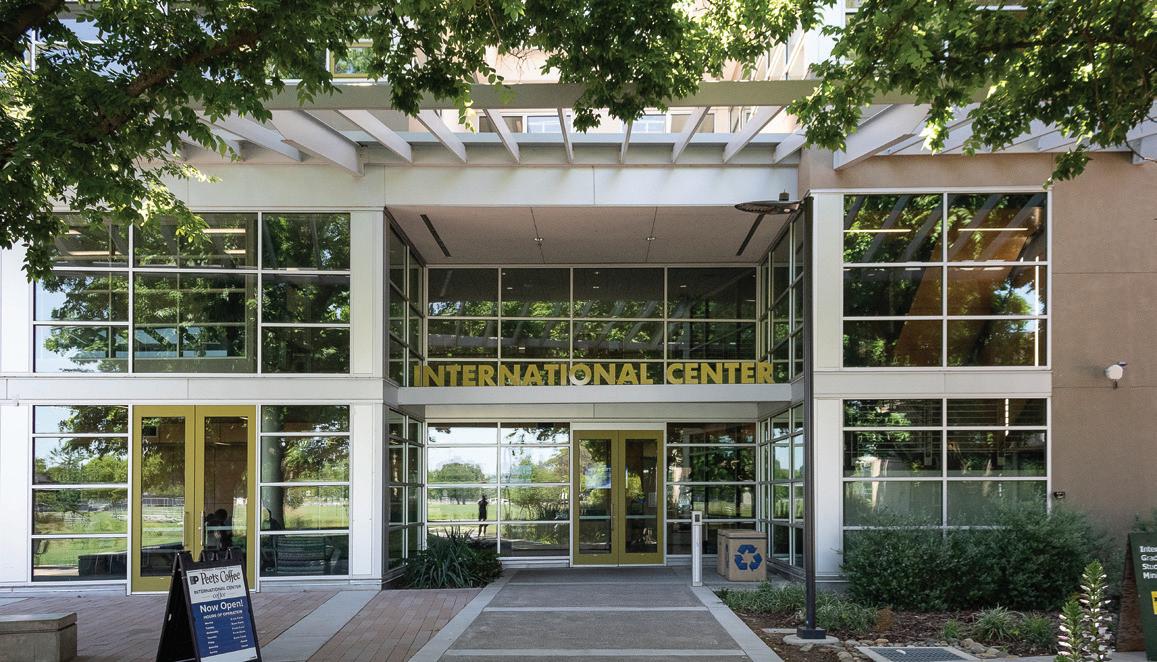
Turning Point USA logo. (Turning Point USA / Courtesy) with the student organizers to create an environment where freedom of speech can be exercised, including for those wanting to protest the speaker,” Easley said. “UC Davis has developed a comprehensive safety and security plan and is staffing appropriately for public safety needs.”

that are anti-trans and anti-LBGTQ+, such as calling those who identify as LGBTQ+ a “social contagion.” Kirk spoke at UC Santa Barbara on March 1, where he called the East Palestine, Ohio train derailment a “war on white people.”
According to Julie Ann Easley, a media specialist for UCDPD, campus police have plans in place for the event regarding security. This includes capping attendance of the event at 1,000 and requiring evidence of registration to attend.
“In preparing for the student event, the campus has been working
At the last TPUSA event, UCDPD was not deployed despite escalation; instead, private security stepped in according to the Oct. 25 press release. According to the press release, campus police were not deployed because the situation was de-escalated without any serious injuries.
UC Davis speaker event hosts Georgetown University expert on Uyghur crisis
The talk, led by James Millward, gave background and perspective on controversy in the Xinjiang region
BY SONORA SLATER campus@theaggie.org
James Millward, a professor of intersocietal history at Georgetown University, came to UC Davis on March 2 to speak on the crisis in the Xinjiang region in China. The free event offered background and perspective on the topic of “colonialism and control in the Uyghur region in China,” according to a recent press release.
The Uyghur population is predominantly Muslim, and the press release states that these people have “been subject to imprisonment, surveillance, religious intolerance, forced labor and forced sterilizations [...] by the Chinese government since 2014.”
According to an article by the BBC from May 2022, several countries, including the U.S., have previously accused China of committing genocide in this region. In late 2021, an independent tribunal ruled that China committed genocide against the Uyghur people through birth control and sterilization with “genocidal intent” to erase the Uyghur culture and diminish their population, after hearing from more than 70 witnesses.
Despite this, the International
Criminal Court (ICC) has said that it will not investigate the allegations because China is not a member of the ICC and is therefore outside of its jurisdiction. According to an article by Forbes from 2020, there has been a push for the council to follow the precedent set in the case of Myanmar, a nonmember state. The ICC investigated cross-border crimes committed by Myanmar after the people there were forced to flee to Bangladesh, an ICC member state. Evidence that cross-border crimes by the Chinese government occurred within Tajikistan and Cambodia, both member states, could similarly allow the ICC to investigate the situation of the Uyghur people. However, so far the ICC has not agreed to take the case, and the Chinese government continues to deny all allegations of abuse.
The controversy was brought into the public eye with the 2020 release of Disney’s live-action Mulan, part of which was shot in Xinjiang, according to Amanda Aguilo, who is the program coordinator for the East Asian Studies Department at UC Davis. Aguilo went on to say that part of the reason the department made the decision to host this event was to ensure that the conversation surrounding the issue continues, rather than letting it fizzle out with the media cycle.
“Especially as students, there’s a lot of compassion fatigue, because there are so many worldwide issues that we grab on to and then forget about and move on,” Aguilo said. “So we thought it was important to bring up this issue and continue the conversation with an expert.”
Millward teaches Qing, Chinese, Central Asian and world history, and his specialties include historical and contemporary Xinjiang, as well as broad knowledge of China-U.S. relations. Aguilo explained that she believes having an academic expert like Millward speak on the topic gives
than

“I’m sure we’re all very familiar with [how] social media news networks are all used to convey ulterior motives,” Aguilo said. “I think coming from a professional who researches this stuff, it’s nice to hear from someone who isn’t going into this with an objective but is just trying to report on it. We can’t be expected to be experts on everything we hear about, so having a professor come gets rid of that barrier.”



Millward also gave some context for his perspective on the situation before beginning the lecture, saying that he was “a historian who got pulled into talking more about the contemporary situation.”
“[This talk is] in the spirit of knowing why this is happening,” Millward said. “Not simply to be critical of China but to try to explain things in a way that might help leaders see a way out of it.”
Millward began by giving a brief summary of the last 20 years of Xinjiang’s history. When 3G cell service became available in the region in 2013, according to Millward, cell phones became extremely common there for the first time. This increased residents’ level of connection with the outside world but also resulted in Whatsapp messages, voice memos and other information that citizens sent and received being made open to digital access by the state.
Millward went on to say that a series of terrorist events across China in 2013 and 2014 resulted in strict antiterrorist laws and security protocols, which collectively became known by the international media as a new security regime.
This included checkpoints where citizens’ phones were checked, QR codes on doors to check who was living at each house, increased police presence, the use of facial recognition technology and the gathering of information about citizens’ religious practices, travel history and so on.
ASUCD is also preparing for the upcoming event by scheduling alternative programming at the same time as the event. According to ASUCD President Radhika Gawde, a finals study session will be held from 5 p.m. to 9 p.m. that night. “ASUCD has been working closely with campus not only in our efforts to provide alternative spaces for students on March 14 but also to ensure that students remain safe if choosing to protest or attend the event,” Gawde said.
After the last TPUSA event, ASUCD released an official statement condemning the counter-protesters who
“We understand that student groups following all campus policies are allowed to bring speakers to campus given the University’s obligations under the first amendment,” Gawde said. “It would be imprudent for members of ASUCD to be involved in conversations that might infringe upon the first amendment right of students even if the values of a group are inconsistent with those of the UC Davis Community.”
Flyers calling for protests to Kirk’s arrival put on by unofficial student group Cops Off Campus have already been posted around campus, according to the group’s Twitter page.
“[The UC Davis police] recognize there is the potential for conflict in settings where individuals are especially passionate about differing points of view,” Easley said. “We are prepared to do our best to deescalate potential incidents.”
UC Davis ends COVID-19 state of emergency
The university put an end to its pandemic public health policy on Feb. 28
BY KAYA DO-KHANH campus@theaggie.org
On Feb. 28, UC Davis ended its COVID-19 state of emergency alongside the state of California, according to a letter from Chancellor Gary May on Feb. 17. The campus also ended its Interim Public Health Policy 290-01, which was aligned with county, state and federal guidance to prevent the spread of COVID-19 on campus, in addition to ending the daily symptom survey.
“While we still have infections in our community, the impact on our lives is much different from when the pandemic started three years ago,” May said in the letter. “Disease prevention has shifted in that time from public health requirements to individual responsibility.” Additional rules that will end with the ceasing of Public Health Policy 29001 include requiring the reporting of positive COVID-19 cases, restrictions on events for visitors or volunteers and “Campus Ready” signs and floor markings.
Regardless, the letter strongly encourages community members to continue to report positive cases of
COVID-19 and to take tests when necessary.

The university announced that by Feb. 28, students and staff should also be up to date on booster shots or submit a declination form in Health-eMessaging. Students can schedule free appointments for Pfizer vaccinations and booster shots at the Student Health and Wellness Center through the Health-e-Messaging portal. The free distribution of rapid antigen test kits will continue through the end of the academic year at the Memorial Union information desk, student residence halls and the front desks at the ARC and Shields Library.
“Contrast those dark early days of the pandemic with today’s COVID-19 reality: we have learned a lot about the SARS-CoV-2 virus; antigen tests are widely available and provide results in 15 minutes; safe and effective vaccines are available; safe and effective oral treatments are available; and we have enough PPE for healthcare workers along with high-quality masks for the general public,” Yolo County’s health officer Dr. Aimee Sisson said in a recent press release. “We are in a very different place than we were in March of 2020, and one where it is appropriate to end the COVID-19 emergencies.”
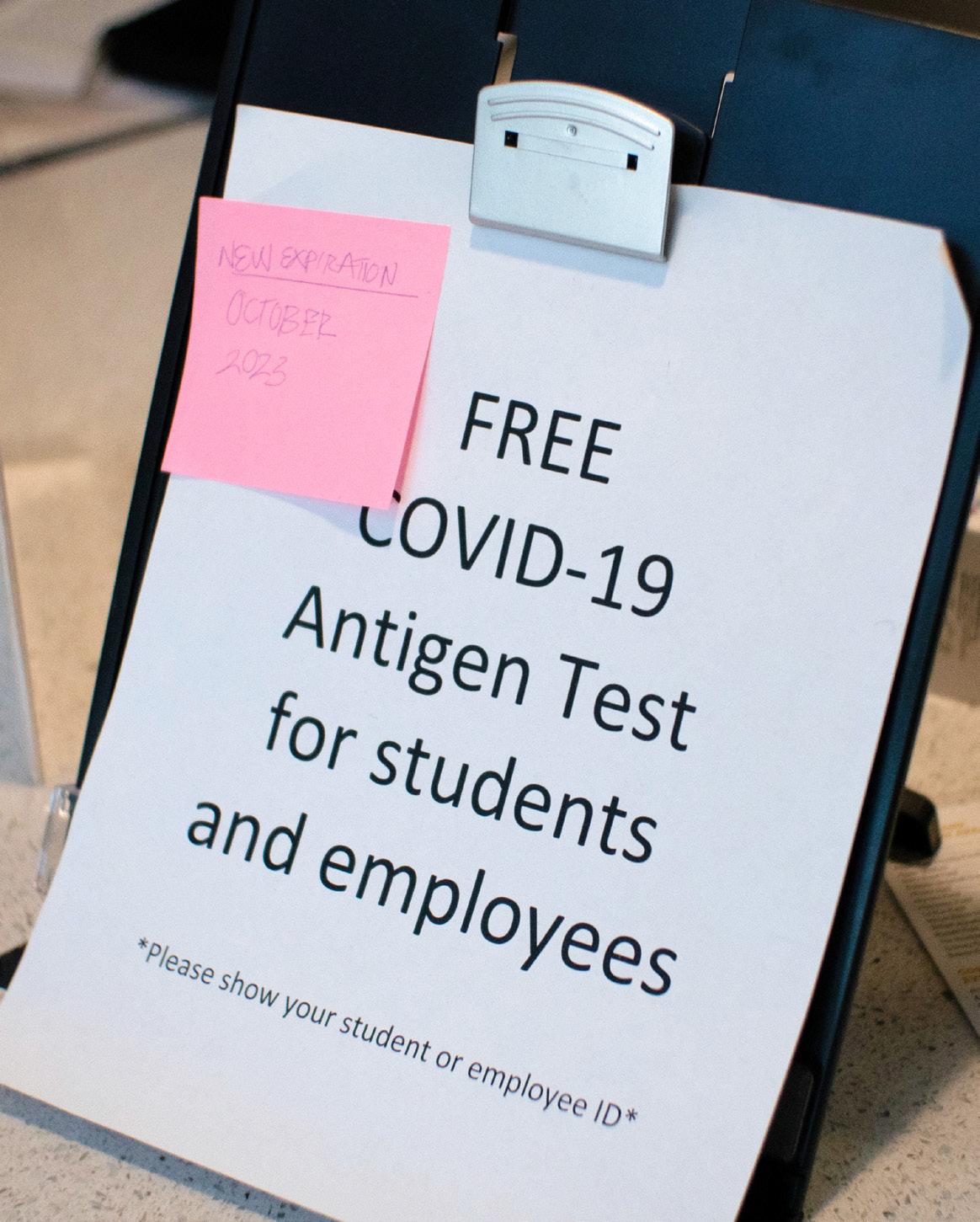
SERVING THE UC DAVIS CAMPUS AND COMMUNITY SINCE 1915 THEAGGIE.ORG VOLUME 146, ISSUE 19 | THURSDAY, MARCH 9, 2023
Free COVID-19 tests are available to all faculty and students free of charge at the MU. (Cruz Martinez / Aggie) READ MORE Commentary: reduce waste by ‘shopping your closet’ SEE PAGE 7 The philosophy behind returning to what is already hanging in your closet before you go thrifting. FOLLOW US ON SOCIAL MEDIA @THECALIFORNIAAGGIE @CALIFORNIAAGGIE @CALIFORNIAAGGIE THE CALIFORNIA AGGIE
DONATE TO THE AGGIE
EASEVENTBRIEF on 4
students a different perspective
the one they might receive on social media platforms.
The event will be hosted in the International Center’s multipurpose room on March 2. (Aggie file)
Chancellor answers questions on housing, return of Turning Point USA at Feb. 28 special session of the Senate
He also noted that the UC Davis COVID-19 state of emergency has officially ended
BY SONORA SLATER campus@theaggie.org
At 6:10 p.m. on Tuesday, Feb. 28, Vice President JT Eden called the special session of the Senate to order. He called roll, establishing quorum, and read the UC Davis Land Acknowledgement.
The meeting then moved into a presentation by UC Davis Chancellor Gary May, which was the main purpose of the special session.
May first thanked the Senate for their recent work serving the UC Davis community before diving into his presentation. He began by noting that UC Davis had ended its COVID-19 state of emergency that morning, along with officially ending the campus’s daily symptom survey. He said that free antigen tests are still available at various places on campus, and community members are still encouraged to test if they experience symptoms.
“No one is sad about any of this,” May said, referring to the end of the state of emergency. “The infections continue, but the impact is so much different than it was three years ago.”
He then talked briefly about the collaborative campaign launched in January by UC Davis and the city of Davis known as “Hate-Free Together,” which was launched in response to a series of hate incidents, with the goal of combating discrimination in the Davis community.
May connected this to the larger issue of hate speech being discussed in the Davis community, making a brief statement about the upcoming speaker
event hosted UC Davis’s chapter of Turning Point USA (TPUSA); the group’s last speaker event was canceled before the talk began after protests outside turned violent.
“Hate speech is a complicated issue,” May said. “It’s protected under the first amendment — as a public institution, UC Davis is obligated by law to guarantee freedom of speech and expression, which is central to our higher education vision. In dealing with hate speech, I believe our best way forward is not to silence those whose opinions we find offensive but to rebut them, ignore them, condemn the hate and empower with something better.”
Next, May talked about the university’s goal to be designated as a Hispanic-serving institution by next fall, which is defined as a higher education institution with 25% or more total undergraduate Hispanic or Latino student enrollment. According to May, UC Davis currently falls about 300 students short of this designation, with 24.7% Hispanic enrollment. He said that once it earns this designation, the university will be able to apply for certain grants.
The final point of May’s presentation was focused on highlighting plans for the spring commencement ceremonies, which will take place at the Golden 1 Center for the first time.
The floor was then opened to questions.
Senator Priya Talreja asked for an update on the Fossil Fuel Free plan, and May said that a draft report will be available soon for feedback. Senator
Paul’s Place opens to provide shelter and services for unsheltered and at-risk populations
Gaius Ilupeju asked for May’s help with promoting the upcoming spring ASUCD elections in order to improve voter turnout, and May said he would be happy to collaborate with the Senate table for that purpose.
Fujimoto asked about whether the university is looking to add more oncampus housing, following stories of students lining up overnight at leasing offices to sign a lease.
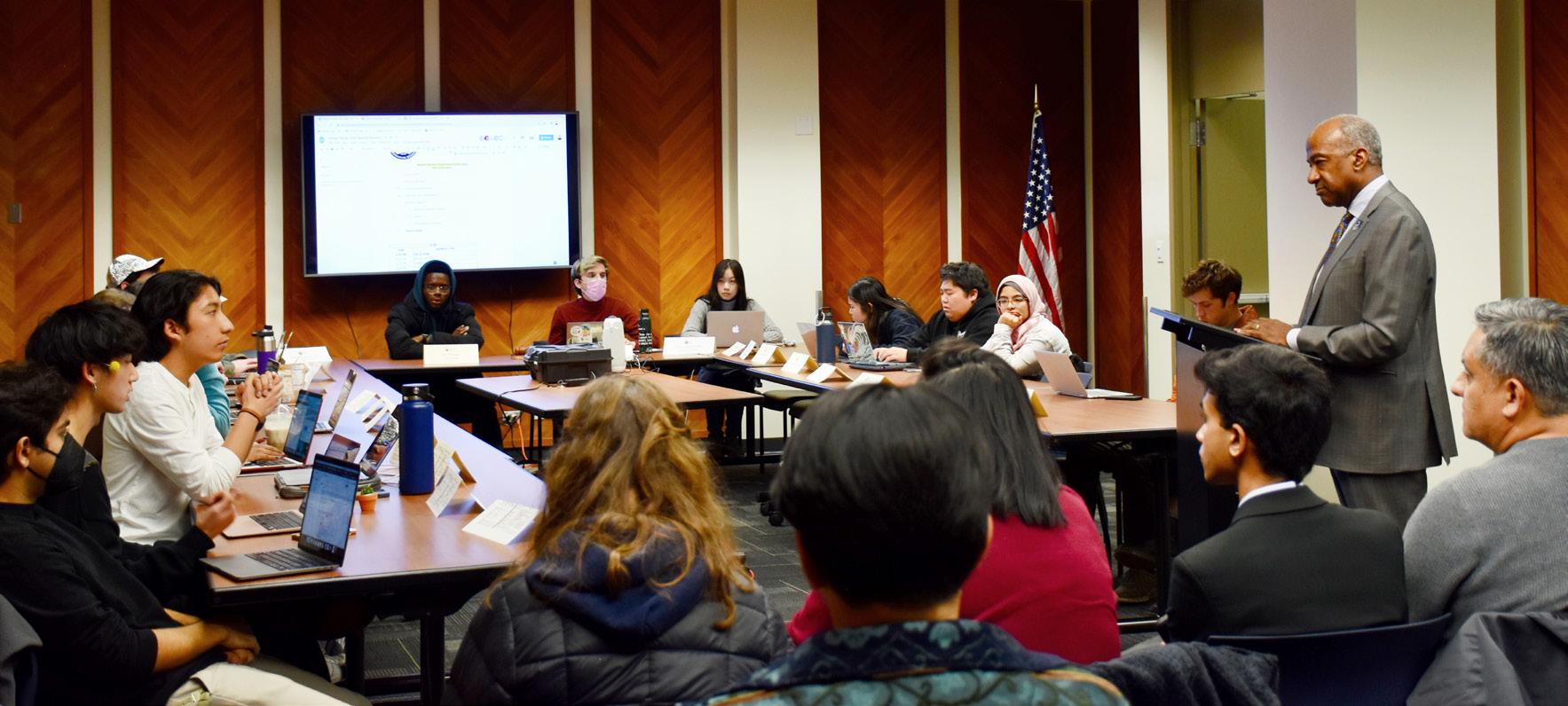
“There are some activists in the city who want us to do more; they want us to build higher,” May said. “But if you go higher, it’s more expensive, so that’s not the solution we want to go with. We think that if we encourage more construction around the campus to push down prices, that’s probably better.”
Transfer Student Representative Logan Ueno also asked about housing. Ueno specifically asked about a proposal to change the leasing period at The Green to just during the school year as opposed to a 12-month period.
Vice Chancellor for Student Affairs Pablo Reguerín, who was present at the meeting in the audience, said that the price point per month will increase because of this change, but that it is being proposed to better align the time when rent is due to when financial aid applies, and therefore decrease the net cost to students. In response to followup questions, he added that they will have “summer school housing” available and will work with reentry students or others who stay on campus over the summer on a case-by-case basis.
SPECIALSENATE on 8
The Innovative Vertical Home Village on H Street hopes to use joint housing and service resources to address the Davis housing crisis
Construction set to begin on Bretton Woods Affordable Senior Apartments in North Davis but community is divided
The development promises to develop 150 affordable housing units for seniors in the city of Davis
BY ANTHONY W. ZAMMIKIEL city@theaggie.org
The Department of Community Development & Sustainability is continuing to review the design application submitted for the Bretton Woods Affordable Senior Apartment Project, formerly known as the West Davis Active Adult Community, as the project is set to begin the construction phase.
“The proposed project will develop 150 affordable housing units for seniors,” according to the Development Projects section of the Community Development & Sustainability page on the city of Davis website. “The project includes two 75-unit residential buildings that will be 4-stories each and one freestanding 1-story community building.”
According to the applicant narrative and justification submitted to the department for the development project, the development will take up 5.64 acres of a larger 70 acre masterplanned community development project. This comes after the Davis community voted to approve the plans in 2018. The development project will satisfy affordable housing requirements, with the 150 residential units including studios, 1-bedroom, and 2-bedroom units.
The West Davis Active Adult Community development project was first proposed to the Davis City Council in 2018, and an amended development plan was approved after successive amendments to the original ordinance.
After being approved, the Davis community voted to affirm the decision within the vote for Measure L. According to the measure notice, all city ordinances require voter approval for projects that change the City General Plan’s land use designation. The development required a change of land use from agricultural to urban, so therefore needed voter approval.
However, the decision to approve the measure occurred before the state of California voted in the 2020 state election to approve California Proposition 19, which changed tax assessment transfers and inheritance guidelines by increasing the property
City council is considering adding housing on an empty plot of land on Covell Blvd. (Christine Minarik / Aggie)

tax rate for inheritance properties. This allowed for property owners above the age of 55 to receive an increase in tax benefits. The Bretton Woods Affordable Senior Apartment development supported Proposition 19 and included online resources describing the proposition, detailing how it helped to create more senior housing and why community members should support the proposition.
However, the decisions to approve the initial development project and subsequently affirm the construction phase have encountered polarized responses throughout the Davis community. Barbara Williams, a Davis resident, expressed her appreciation for how the community understands the need for focusing on senior housing developments, and is prioritizing affordable housing.
“As someone who, if we are being honest, is just a little bit over the retirement age, I highly approve of the measures by the city in the previous four years to prioritize affordable housing for us seniors and allowing us more opportunities to continue living in this city, especially since we have our roots here,” Barbara said. “It is fortunate that I am in the position that I am in. However, I know too many people who have been pushed outside Davis because there are just not enough places for seniors to live here.”
Gigi Williams, another Davis community member, believes the city of
Davis has become less anti-growth and argues that the city should not develop into the surrounding agricultural areas. Gigi is concerned that Proposition 19 has not been not applied equally to all California residents, and the Davis community is no exception.
“Let’s be honest here, Prop 19 and other similar propositions over the years concerning home ownership have historically benefited white Californians and there is a real storied history about people of color being blocked from home ownership in this state, either by implicit or explicit policies,” Gigi said.
“Who are the people who are buying homes for the first time? They are Black, they are Latinx, they are Indigenous, they are largely people of color. And Prop 19 focuses on prioritizing these longtime homeowners instead of helping us folks out.”
More information concerning the Bretton Woods Affordable Senior Apartments can be accessed under the Development Projects section on the Community & Sustainability Development page on the city of Davis website. The development plans include both the applicant narrative and justification submission and the development schematics. More information about the development process when the plans were originally submitted as the West Davis Active Adult Community can be located in the Approved & Pending/Under Construction section.
BY MADELEINE YOUNG city@theaggie.org
On Feb. 7, Paul’s Place, an innovative four-story home village project in Davis, opened with the goal of providing permanent and transitional housing for at-risk and unsheltered community members. The facility is owned and operated by Davis
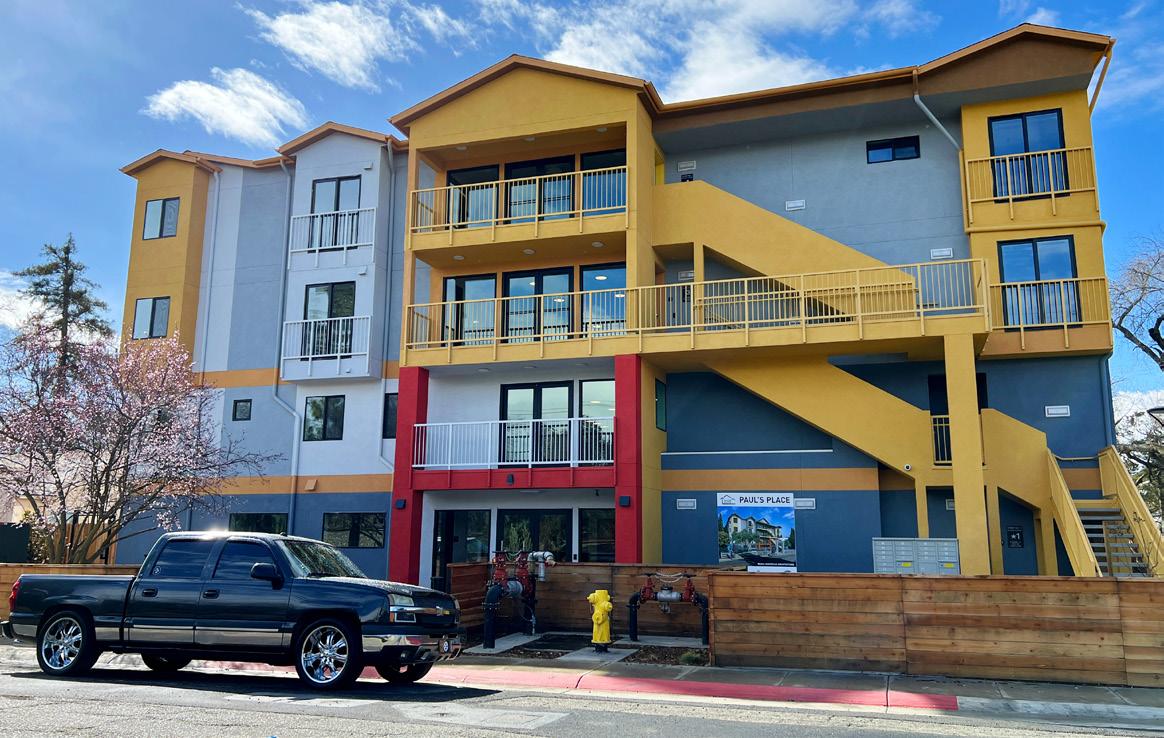
Community Meals and Housing and includes four emergency shelter beds, four staff offices, a kitchen and dining area, laundry, five bathrooms, a resource center and a community room.
Executive Director of Davis
Community Meals and Housing
William Pride explained how the idea came about and how Paul’s Place was developed. “Paul’s Place was an idea that kind of formed back in 2016 and 2017,”
Pride said. “We had a facility at the location where Paul’s Place is now, that we’ve been using for many years and it became really rundown and at the same time, there [were] discussions happening because Sutter Health in Sacramento had started an initiative called the ‘Getting to Zero’ program and they were going to put a lot of money [to] fund developing programs to help homeless people and other folks in need. Through those communications, we came up with the idea to replace what we already had there with a facility called Paul’s Place.”
Paul’s Place is not only a transitional and permanent housing program, but it also provides different resources and programs for residents, making it the first of its kind in Davis. Pride explained some of the services Paul’s Place offers.
“It combines a couple of different programs all in the same building, not just apartments,” Pride said. “It’s a shelter, resource center and a transitional-housing program set aside exclusively for people who are homeless in the community in Davis and surrounding Yolo County.”
City of Davis Mayor Will Arnold addressed the recently finished project during the State of the City address on March 1. Arnold said that this project could be the blueprint for future projects that aim to help unsheltered and at-risk populations.
“A key piece of our housing portfolio is finding ways to provide housing for those most in need of a roof over their heads,” Arnold said. “I was so proud to be able to speak and participate in the opening of Paul’s Place. It’s a new vertical tiny home village that includes emergency services and supportive housing, supported directly by the city of Davis. It’s going to be something that has never quite been done this way anywhere and this could be a model for how we unite housing, shelter and services for folks most in need.”
PAULSPLACE on 4
A Change of Pace Foundation holds 40th annual Davis Stampede community marathon
Despite the rain, runners from across Northern California traveled to Davis for the races
BY ALEX UPTON city@theaggie.org
On Feb. 26, A Change of Pace Foundation held the 40th annual Davis Stampede marathon at Playfield Park in South Davis. Other than the marathon, there was also a 5k, 10k, half-marathon and family- and dog-friendly 2k run. Despite the rainy weather conditions, runners from across Northern California showed up for the event.
A Change of Pace Foundation is a non-profit organization that encourages a healthy lifestyle, according to its website. Based in Davis, the foundation hosts marathons in Davis and partners with events across Northern California and the West Coast, using their advanced chip technology to time events. Their mission statement is to “encourage, educate and motivate kids to inspire life-long habits towards a healthy lifestyle.”
Many local Davis families showed up for the event. James Escobedo, a sophomore from Da Vicini High School, was there to support his dad on his 53rd birthday.
“Ten years ago he was told he could never run again after he hurt his knee, but he’s powered through it and is just doing smaller marathons now,” Escobedo said. “We’re really proud of him.”
Jennifer Baker, a human resources manager, came out to Davis from Roseville to run. While she said that the California International Marathon
held in Sacramento is her favorite race, Baker enjoyed the Stampede and looks forward to running it again next year, hopefully with better weather.
“It was fun except for the rain,” Baker said. “I don’t mind the rain, but I would prefer if it wasn’t [raining].”
Runners of all levels were welcome at the race. Avery Lajeunesse, a law student at UC Davis, ran the 5k after his girlfriend signed him up. He is not a runner but said he was happy to participate.

“[The race was] more difficult than I would’ve liked it to be, but I finished so that’s cool,” Lajeunesse said. “That’s all I wanted to do today.”
Alicia Rodriguez came down from Galt with her partner and his son. Rodriguez, an avid marathon runner, ran the 5k as a cool-down from her last marathon in Texas. Her partner and son ran the family 2k together.
“I’m recovering, so I wanted to hit and run the 5k to kind of get back into it,” Rodriguez said. “It was great, I’m glad I came.”
Aside from the Davis Stampede race, A Change of Pace Foundation also puts on other races throughout the year. Alexis Johnson has worked as the race registration coordinator for the company for over a year. She registers participants and manages any problems runners may come across. When talking about her favorite race to run, Johnson said, “There’s a moonlight one, and you get a beer at the end so that one’s really fun.”
2 | THURSDAY, MARCH 9, 2023 THE CALIFORNIA AGGIE
Paul’s Place will provide services and housing to address homelessness in Davis. (Kazim Jafri / Aggie)
AGGIE FILE
UC Davis Chancellor Gary May listens intently to the concerns of an ASUCD Senate member. (Maia Zhu / Aggie)
Black Panther Party co-founder Bobby
Seale spoke at California Hall for Black Futures Month
The historic civil rights leader continues his legacy with words of inspiration for Davis students
BY DANIELA DULA MEJIA features@theaggie.org
“It [was] absolutely surreal,” said Dionica Bell, the director of the African American Retention Initiative and the Center for African Diaspora Student Success (CADSS). “How often do people get to say that the things they grew up learning about and the moments that changed the trajectory of our stories [are] sitting across from you.”
On Thursday, Feb. 23, 86-year-old co-founder of the Black Panther Party (BPP), Bobby Seale, spoke to a crowd in California Hall. The BPP was an international group that was originally formed in 1966 in Oakland, California. Seale and Huey P. Newton, the other co-founder, worked to protect Black citizens from police brutality. Seale and the BPP also worked to create programs such as the free breakfast program that are still in place today.
Seale was invited to speak as the Keynote Speaker for this year’s signature events for Black Futures Month. Attendees came from as far as Fresno, California, to listen to him talk.
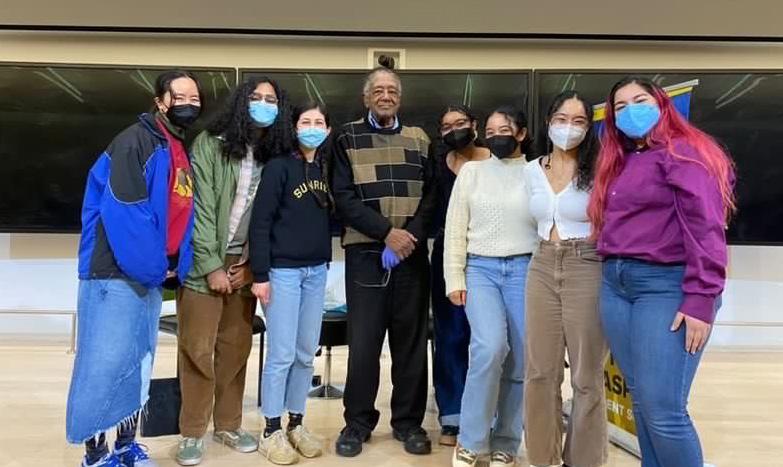
Student powerlifting club
Aggie Barbell humanizes an intimidating sport
UC Davis students in Aggie Barbell discuss resources, culture and stigmas in powerlifting
BY REBEKA ZELJKO features@theaggie.org
“I thought what better way than to find a piece of our history around social justice during Black Futures Month,” Bell said.
Black Futures Month is a campuswide celebration that is held each year for the entire month of February. According to the UC Davis Diversity, Equity and Inclusion website, “Black Futures Month is a shared vision of the trajectory for Black life on the UC Davis campus & beyond. During the month of February, we are committed to remembering, celebrating & learning from Black History.”
Each week, different campus centers held community events. The Women’s Resources and Research Center (WRRC) hosted Black Femme Magic Week from Feb. 13 to 17. The LGBTQIA Resource Center and the Cross Cultural Center (CCC) also hosted events such as “Reimagining Black Love: Film Screening & Artist Talk.” CADSS was in charge of programming for the final week.
Everyone’s journey to powerlifting looks different. But for many at UC Davis, the community that Aggie Barbell has created seems to be a common thread.
Aggie Barbell is a student-led powerlifting club that was established in 2014. “Aggie Barbell Club has something to offer for everyone, no matter your experience level,” according to their website.
“For those who treat lifting as a lifestyle and have years of experience, we offer the opportunity to add another dimension to your training,” the website reads. “For those who are new to lifting and don’t know where to start, we offer workshops to guide you along your fitness journey.”

Trent Hurtado, a fourth-year political science major and student coach, started powerlifting during his time at UC Davis.
“I got into lifting about two years ago, but I usually like lifting by myself,” Hurtado said. “I’m really stubborn and close-minded with my schedule, but Aggie Barbell is a good way to kind of break away from that and get more involved with my friends.”
Hurtado said the club offers a sense of support in a sport that can be intimidating to many people.
“It was a cool opportunity to combine the social aspects with my hobby,” Hurtado said. “And [it] will cheer you along and offer you moral support, be a bit of a rock.”
An experience shared by many gymgoers is the initial difficulty of getting involved in the sport. Erica Chau, a third-year cognitive science major, said that her feelings of intimidation were reduced by joining Aggie Barbell.
“My interest in powerlifting happened around my first year when I started going to the gym,” Chau said. “I always wanted to power lift, but I was very intimidated and inconsistent with going to the gym. But once I began to learn more about the sport, I became more committed when I made friends

Members of the Davis Alpine Ski and Snowboard team placed impressively at this year’s regional championships in Mammoth Lakes
The Davis Alpine Ski and Snowboard Club is looking forward to nationals this month
with people at the ARC and from Aggie Barbell.”
Chau said the community created by Aggie Barbell encouraged her to pursue her interest in powerlifting and also gave her a support system.
“I met the members at the ARC and befriended them one by one, and they said that I’m basically in the club,” Chau said. “I’m glad I’m a part of the club because it allowed me to be more serious about the sport while having fun with my friends.”
Alli Ngo, a third-year biological sciences major, said that her involvement with the club has contributed to her progress in her social life and selfconfidence.
“Before joining, I basically only talked to my roommates, but now I have this whole group of friends,” Ngo said. “When I first started lifting, I was
super intimidated. I would go at hours when it was super crowded, and I was worried people would be staring at me or judging me. But people really just mind their own business. Like when I go, I look at other people not because I’m judging, but I’m admiring them. I’m like, ‘Wow, she is really strong.’”
Hurtado said the intimidation at the gym is normal and more common than many people think.
“When you go to the ARC and see massive dudes in cut-off tank tops, it’s easy to understand why people are nervous to go to the gym,” Hurtado said. “But in reality, a lot of people luck their way in. Not to diminish any of their hard work, but nobody is as sure of what they are doing, and they all lack a bit of confidence, and that’s okay.”
BY FAITH DEMEULENAERE features@theaggie.org
The Davis Alpine Ski and Snowboard (DASS) competition team’s recent performance at the regional championships is a shining example of how the power of hard work, perseverance and teamwork can bring home a win.
Feb. 20-21 in Mammoth Lakes, California, DASS went head-to-head with other collegiate club teams in a slalom and giant slalom race, which consisted of sharp turns around obstacles down a steep hill.

DASS placed first in men’s ski giant slalom, second in men’s ski slalom, second in women’s snowboard giant slalom, third in women’s ski giant slalom and slalom and took home almost every ranked place in rail jam, a timed run on a rail course judged by best overall and best trick.
After a successful first day at the race, the second day was full of highspeed winds. Lauren Bryant, a third-year human development major, snowboards for the DASS team and raced for her first time at regionals this year. Bryant said regionals were “stressful with a storm coming in.” However, the DASS team prevailed and brought home some high scores.
“Shredding” like this cannot be done without practice, but members of DASS all prepare differently for the races. Some try not to think about it too much, like Preston Longley, a fourth-
year genetics and genomics major, who said his routine consists of “intensive sleep and a bagel.”
Others, like Justin Wallasch, a fifthyear managerial economics major, have tight rituals. “I have been racing for around 20 years, so I’ve definitely got a routine down,” Wallasch said. “It consists of a lot of boot skiing and leg swings to keep me warm and my muscles active when waiting before a race. I don’t like to overthink a course, so I try not to focus too much on the race before I go.
I think it’s important to have a clear and good headspace.”
DASS Team Captain, Yaz Wadhwani, a fourth-year neurobiology, physiology and behavior major, has been a member of DASS for four years. Though she sadly could not race due to medical reasons, she helped the UC Davis team prepare in every other way she could.
“Skiing is my absolute favorite thing to do, and although I can no longer race, there’s nothing like being on the mountain to support my team,” Wadhwani said. “For them, I make sure I have a backpack with a fully-stocked medical kit, a radio down to base, a full water bottle and extra race bibs. At regionals this year, I had to give out my poles and gloves to my team when theirs got stolen. After the race, I’m the last down the mountain and carry all the jackets my team left behind when they ran the course.”
THE CALIFORNIA AGGIE THURSDAY, MARCH 9, 2023 | 3
10
BLACKPANTHER on
Trent Hurtado and Lucas Sison, members of campus weightlifting club Aggie Barbell. (Trent Hurtado / Courtesy)
Davis Alpine Ski and Snowboard team gets ready to race at regionals. (Samuel Baron / Courtesy)
Students take a photo with Civil Rights Leader and the Black Panther Party co-founder Bobby Seale. (Dionica Bell / Courtesy)
ALPINESKI on 10 AGGIEBARBELL on 10
You don’t have to have it all figured out
Losing yourself is the path to self-discovery
BY YASMEEN O’BRIEN yjobrien@ucdavis.edu
As my graduation date approaches, I’ve been feeling pressure to get my life in order. But every time I take a step back to think about it, I realize that the whole point of being a college student is to experiment and discover my identity. I was hesitant to write this piece at the risk of sounding cliché, but I decided it’s helpful to hear this, even if you’ve heard it before.
As college students soon to enter the “real world,” it’s common to feel a sense of confusion about who we are, what we’re doing and how the world works; the list goes on and on. We wonder who we’re supposed to be, which, in our society, is defined by what we do for work. This pressure to plan out our lives can suffocate us, and it’s important to give ourselves the space to figure it out. This is where losing yourself comes in.
So, what does it mean to lose yourself? It means not knowing who you are yet or everything you like and don’t like and owning the fact that you’re still learning. It means to do all kinds of experimenting; to try new things and take risks that may feel “out of character” but excite you. It means making decisions that don’t pan out the way you thought they would and learning from them. It means making mistakes. It means feeling confused and unsure about how your future will fall into place.
I recently went through a period of feeling lost, which I know is not uncommon. I was experiencing confusion about what I wanted to do with my life and was hard on myself for wasting time and changing my mind.
I thought I wanted to be a doctor, but after two years of studying biology, familiarizing myself with the process of becoming one and deeply understanding the work they do, I came to the conclusion that it wasn’t for me. It didn’t excite me. The more I learned, the more I couldn’t picture myself in that profession. I was afraid of my parent’s reaction and upset that I was unable to stick to my plan.
One day, I realized I had been focusing too much on the negatives of being confused. It was important to embrace the confusion. It was okay that I changed my mind. It was natural; necessary even. I hadn’t wasted time
because I discovered my true calling and learned so much in the classes I took. I don’t have any regrets.
I have come to learn that losing yourself is really the only way to discover who you are. Life experience is the best education you can get, and losing yourself in the search for your identity, in love, in your studies and even physically can teach you valuable lessons. But it can be difficult to do this, and it’s easy to feel inadequate when you don’t “figure it out” and meet the expectations of yourself and others.
Allowing yourself to take a step off the beaten path gives you the experiences that shape who you are. It gives you a chance to make your own decisions — albeit with some trial and error — and find out what you truly like and dislike. Losing yourself in college also allows you to feel your emotions deeply — which is not an easy task, but an incredibly important one.
This brings us closer to ourselves and one step closer to leading a fulfilling life, in which we set boundaries for ourselves and respect them and feel strong in our identity and comfortable enough to open ourselves to others.
Additionally, remember that losing yourself is always temporary. You will find your way back. It’s important to remember that, as young people, our
We can’t keep acting too late on climate change issues

Key climate takeaways from Utah’s Great Salt Lake
BY EMILIE BROWN emrbrown@ucdavis.edu
In early January, a new study by Brigham Young University (BYU) predicted that the Great Salt Lake just outside of Salt Lake City, Utah, is on track to completely disappear within five years. The lake is a habitat for 10 million migratory birds, feeds millions worldwide through fertilizer and brine shrimp and generates $2.5 billion in economic activity every year. It also increases precipitation, suppresses toxic dust and supports Utah’s wetlands. The study showed that, without a coordinated conservation plan, we can expect widespread air and water pollution, numerous endangered species act listings, agricultural declines and health issues for people living near the lake as a result of its disappearance.
identities are supposed to change as our lives change. That’s how you grow. Odds are you’ll come out of a period of growth as someone stronger, more in touch with your needs and desires and more empathetic — kinder to others and yourself. So really, losing yourself is how you find yourself. You have to lose yourself, in many ways and many times. Each time, you’ll connect with yourself in a new and important way. I think that’s one of the purposes of the human experience. It’s confusing not to feel grounded, like the Earth has been swept from under your feet, but I think this lack of feeling grounded gives us the ability to find what grounds us. Enjoy this journey.
So take a class that interests you outside of your major, go for a walk with no destination or take a chance on someone. Give yourself the opportunity to marvel at something, to take a leap of faith, to try something completely new, to lose your way. That is the greatest gift you can give yourself.
Disclaimer: The views and opinions expressed by individual columnists belong to the columnists alone and do not necessarily indicate the views and opinions held by The California Aggie.
My journey learning time management in college
Keeping track of deadlines is the key to being the best student you can be
 BY JENA TUFAIL jjtufail@ucdavis.edu
BY JENA TUFAIL jjtufail@ucdavis.edu
Managing time in high school was always easy for me. Remembering the set schedule of classes I had every year and knowing that, for the most part, every day would run on a similar schedule always put me at ease. I knew what my school days looked like, I knew what to expect after school and I knew what my weekends and breaks would be like too. However, coming to college I didn’t realize how much this would change and how lost I would feel in the beginning of my undergraduate education. I know many of you also felt the same, and missed the consistency we had in our lives before college. When I had my first day of the quarter a little over a year and a half ago I remember feeling so lost and stressed. The system I had in high school could not work any longer, and that idea was difficult to comprehend at first. Everything was changing too quickly, and I felt like I wasn’t ready for it.
My first couple weeks at Davis I seemed to be managing fine, but by the time midterms came around I had so much on my plate that I was starting to forget everything. Long gone was that set schedule I had every day. Instead, every day looked so different and it began to drive me crazy.
There was no such thing as “office hours” in high school, or club meetings that ran at different times or meetings I needed to remember with TA’s or professors. Not only do we have these circumstances to be on top of, but work schedules, internships schedules, assignments and class times to remember too! I remember beginning to think that I needed to figure out a system of time management that worked for me, or I’d lose out on a lot of things because of my poor time management.
I started my journey of managing my schedule by printing out monthly calendars and writing my to-do list in the margins. It worked for some time, as writing my schedule and what I had to do helped me retain it better, but I quickly learned it wasn’t the best idea for time management and that it wasn’t going to work well in the long term.
The next step I took was buying a planner and taking it along with me everywhere. I used this system in high school AVID and it worked well for me at the time, but as a college student I didn’t feel like the system was convenient or mobile enough for me. For days at a time I’d forget to open my planner and again relied on remembering things off the top of my head or consistently checking random notes I had written elsewhere or on random sheets of paper.
After this, I started by writing my to-do lists in the notes app on my phone,
which worked well for me, but only if I remembered to check. By then I had learned of Google Calendar, which was finally able to help me come up with a system that worked for me.

With Google Calendar, I was able to input tasks and to-do lists and check them off every day. What was even better is that I could upload my assignment due dates from Canvas onto my calendar, which helped me stay way ahead of my deadlines like never before. I was able to put information for meetings I needed to attend over Zoom as well. For the first time, I figured out a way to manage my time and schedule that worked for me. It can be hard to find a system of time management that works, and it can take a lot of trial and error to find exactly what’s best for you. It’s a journey that all students have to go through. College is a lot to handle, and even more so when you’re lost trying to navigate your day to day. Everyone has times when they have a lot on their plate, but figuring out a system to manage your time and the deadlines you have to meet is a great way to lessen your load and become the best student you can be.
Disclaimer: The views and opinions expressed by individual columnists belong to the columnists alone and do not necessarily indicate the views and opinions held by The California Aggie.
In response to the report, the state of Utah almost immediately began efforts to conserve the lake and has developed a $500 million plan to conserve the Great Salt Lake.
However, we’ve known that the Great Salt Lake was drying up for years and the effects that could have. As a climate-change-fueled megadrought has swept the West, the Great Salt Lake has suffered. Already, it has lost 73% of its water and 60% of its surface area. So why are we only taking serious action to conserve it now? Why are we only spending so much on it now? Why are news outlets and city councils only talking about it now?
We keep acting too late on climate change issues. This is just one of thousands of examples.
These days, it’s easy to say you care about climate change. Yet a larger and larger gap is growing between caring about it and acting to help stop it.
It’s easy to say you’re going to cut back your single-use plastic use, lower your meat and dairy intake or recycle more. But unless the solutions are incredibly easy or the problems’ effects are so apparent we cannot ignore them, few of us take action in our day-to-day lives. For the Great Salt Lake, serious actions were only taken after the effects of the lake drying up were already starting to become a problem and the issue was impossible to ignore. Ice caps melt, wildfires rage, ocean levels rise. Scientists predicted this could happen if we continued on the same track. But only now that the damage has been done do we start to care.
While we can’t change the past, we can change how we think and act about climate change issues today. Instead of procrastinating, we need to start taking small actions now. Whether that is commuting via bike instead of a car, buying oat milk instead of cow’s milk or washing your clothes on cold instead of hot, we all make choices every day that impact the environment and we get to choose whether it’s a positive impact or a negative one.
Start thinking about climate change as an issue that is happening now, and start thinking about your everyday actions as actions that can help fight it. .
Disclaimer: The views and opinions expressed by individual columnists belong to the columnists alone and do not necessarily indicate the views and opinions held by The California Aggie.
EASEVENTBRIEF
FROM THE COVER
All of this information, according to Millward, was entered into a database that could be accessed by police, and the data was used to produce a “score” for each citizen; they were essentially graded as being “normal” or as being “potentially dangerous.”
“A process was put in place where people were rounded up if they were scored as being “potentially dangerous,” which launched the opening of reeducation camps,” Millward said. “People were brought into these camps not because they had committed a crime, but because this crunching of data, or this algorithm, said they might commit a crime.”
Although Millward acknowledged the horrors of the camps, he noted an important piece of the attack on the Uyghur people that he said has been less covered by the international media is the attack on their cultural heritage, including through campaigns against wearing veils and prayer in public places, the erasure of the Uyghur script and language and campaigns to tear down domes and recognizable structures on mosques and shrines.
As far as the most recent news about Xinjiang, Millward highlighted the Uyghur Forced Labor Prevention Act, which intended to ban U.S. import of goods made through forced labor in Xinjiang, signed into law by President Joe Biden in Dec. 2021. In Sept. 2022, the European Commission followed suit, initiating a proposal banning all products made through forced labor on the EU market.
The United Nations Human Rights Council is currently in session in Geneva, opening on Feb. 27 and closing on April 4. U.S. Secretary of State Antony Blinken and Minister for Foreign Affairs and Local Government of New Zealand Nanaia Mauhta have
PAULSPLACE
FROM PAGE 2
Paul’s Place received funding from multiple private sources including Sutter Health and Partnership Healthplan of California, as well as local government aid throughout the building process.
“The city contributed approximately a million dollars in American Rescue Plan Act Funds to get it over the hump with its financing,” City Manager Mike Webb said at the State of the City address. City and County officials originally came together to commit to creating
already breached the topic of tensions in Xinjiang at the session, and further discussions are likely to take place, according to a press release from the Human Rights Council on March 2. Millward said that part of the reason why he has hope for the situation is because of the fact that he sees people taking notice of and being outraged at what is happening to the Uyghur people — taking part in international backlash which he said he doesn’t think the authorities in Xinjiang were fully prepared for.
“I think their policies are a miscalculation,” Millward said. “I don’t think anyone expected that the West would see the things happening in Xinjiang and see them for what they are: the worst kind of colonialism, racism and human rights violations. We recognize this and oppose it because we did it ourselves — we’ve seen it in our history books. I don’t think Xinjiang was ready for that.”
According to Aguilo, since this topic is controversial, the department has dealt with people removing posters for the event. However, she believes that just because a topic is controversial, “that doesn’t necessarily mean to stop talking about it.”
“Because there are a lot of efforts to silence the voices speaking out against this, it’s important for us to elevate those voices,” Aguilo said.
In closing, Millward answered an audience question about what would have to happen for things in Xinjiang, and China at large, to change, which he responded to broadly by emphasizing the importance of celebrating diversity.
“I think the way things will change is by understanding the situation, getting away from Chinese exceptionalism just as we are trying to get away from American exceptionalism and recognizing that diversity is actually a good thing to have in a nation,” Millward said. “And that’s where the Chinese people and citizens have a role to play.”
Paul’s Place in 2017 after recognizing the need for additional funding to create solutions for the local housing crisis. Five years later, the project is finally complete.
“We got a lot of community support as being a program that the city would like to see happen,” Pride said. “Throughout the process, we’ve had loads of community and political support from the city which led to us having a grand opening with almost 200 people celebrating. I’m not sure I’ve ever seen a program for homeless folks where a community comes out [to] celebrate it. So it was nice to see the people in Davis rallying around the issue and ensuring its completion.”
4 | THURSDAY, MARCH 9, 2023 THE CALIFORNIA AGGIE OPINION
NATALIE CHENG / AGGIE KELLIE LU / AGGIE
NATALIE CHENG / AGGIE
The decline in enrollment in the humanities is a tragedy for education
As the number of students in the hard sciences grows, we must remember the timeless benefits of the humanities
If you are a UC Davis student, the odds are you’re probably a STEM major — nearly 60% of undergraduates at Davis are pursuing a degree in STEM. In fact, between the 2010-2011 and the 2016-2017 school years, the number of STEM degrees awarded in California increased by 55%. Studying the hard sciences can lead to innovations and new technologies that help improve life and many of these subjects promise financially stable career paths, so the emphasis on STEM is understandable. However, this has led to a decline in the number of students studying the humanities and consequently universities offering humanities courses, which makes getting a well-rounded education more difficult for all college students.
The number of students majoring
SEE ONLINE
Scan to read our editorial about decreasing social media use during finals.
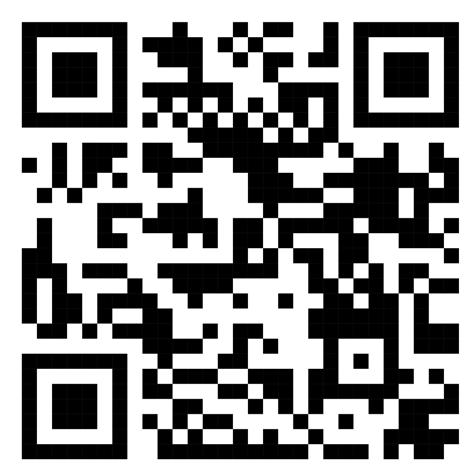
in English across the U.S. has declined by a third between 2011 and 2021, and last year only 7% of Harvard freshmen planned to major in the humanities. More recently, Marymount University, a private school in Virginia, disbanded many majors in the humanities such as English, history, philosophy and sociology. While this specific case involves a small private university, it still serves as a reminder of the growing decline of these fields of study.
Skills taught in STEM courses seem to be more of a priority than writing, critical thinking and communication, which are often taught in humanities courses. This makes sense because careers in STEM fields tend to make higher wages directly out of college. We aren’t expecting you to completely disregard the realities of the housing and job markets, but it is a tragedy for education to devalue the humanities, which help everyone, regardless of major, to develop skills that are applicable to every field.
From those studying biochemistry to engineering, every student needs to learn how to write and communicate well to become successful in whatever field they pursue. Most jobs will require employees to write papers, reports and dozens of emails, and the writing experience that humanities courses provide is essential for students to excel in their future careers.
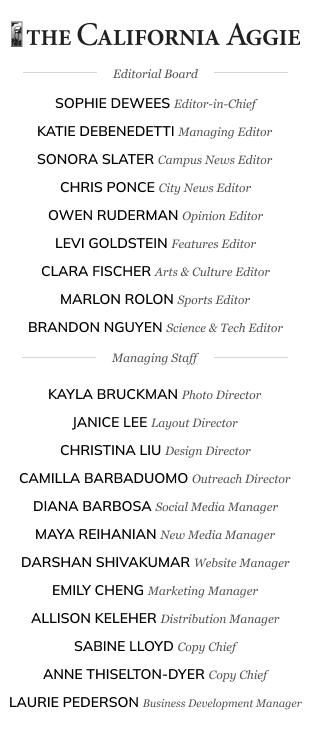
Critical thinking is another skill that is further developed through the study of the humanities. For example, majoring in English requires you to dive into readings and evaluate different authors’ texts. Developing a
level of critical literacy is important when consuming any form of media — regardless of whether it is for work or not.
Majors in the humanities also teach students how to formulate strong arguments, solve problems and assess evidence. In philosophy classes, you learn the reasoning behind commonly believed theories and how to better argue your own. History classes can help you practice understanding, contextualizing and interpreting evidence.
Studying the humanities also helps improve both oral and written communication skills, which will allow you to thrive in all areas of your life and will be especially helpful in a competitive job market. These types of majors and classes that are seen by some as “useless” provide benefits and skills that will last your whole life.
Universities should do more to promote enrollment in humanities courses and support the students who choose to major in these subjects. One way to do this is to provide more resources on the career options for students in these majors. Additionally, universities should encourage or even require all students to take more humanities courses. STEM careers are becoming increasingly valuable in our society, and the money and jobs available in these fields are enticing to students. However, as STEM becomes more popular, the value that the humanities provide should not be forgotten.
WRITTEN BY THE EDITORIAL BOARD

We are what we consume
Entertainment isn’t just entertainment anymore but a vehicle of self-expression; here’s why that’s a problem
BY GEETIKA MAHAJAN giamahajan@ucdavis.edu
It’s 2023, and your identity is an accessory. No — it’s the amalgamation of everything you’ve watched, read and listened to in the past month but only if you’ve posted about how much you loved “The Menu” or how you were in the top 5% of Harry Styles listeners on Spotify. Wait, no, actually, what you perceive as your own individual identity was actually created and handed to you by a virtual algorithm that pigeonholes a broader market into neat little groups of consumers.
Okay. Sorry for all the confusion; it’s actually all three of those things, in that order. It’s 2023, and identity is an inescapable farce and an Apple product that everyone but you seems to have. The truth is, though many cultures propagate the idea of an innate self — the soul, the mind, who we truly are — that we must unearth, there is no scientific or psychological evidence to support the claim that anything about our identities is congenital.
What most people would define as their identity has been, for the most part, malleable. This is not a new phenomenon; at 18, I am not the same person that I was when I was eight, and the same goes for my mother and her mother before her. What distinguishes our present moment from the past is the constant cycle of virtual input informing the construction of our identity and the need to advertise this aforementioned identity to others so that we can finally “feel seen.” Thus, the malleable identity stopped being a vehicle for self-improvement and became an ouroboros of consumption.
Today, there are an infinite number of ways in which we can disseminate information about ourselves. Likewise, there are an infinite number of ways in which we consume information about others. Spotify Wrappeds posted on Instagram, live-tweeted reactions to the newest season of whichever HBO show has caught everyone’s attention and book reviews on TikTok; we are constantly exposed to what those around us are listening to, watching and reading.
This is not the issue though. Obviously, there’s nothing wrong with discussing your opinions about a piece of media or even extolling your love for a certain movie or author. But people are not consuming entertainment for the sake of being entertained anymore. “Liking” or “disliking” is an afterthought — the primary concern is what the consumption of this piece of media says about us.
The content becomes a part of the consumer, in a way that was completely alien before the explosion of social media. Before that explosion, people would listen to certain artists because they liked their music. Now, it seems as though people listen to artists because some intrinsic part of their identity is tied to the artist themselves — because
Taylor Swift fans are mirrorballs and children who crave academic validation, because Phoebe Bridgers fans really do have emotional motion sickness and are currently ghosting their therapists. The content is not just entertainment but a facet of your identity, and you can present it to the world and feel like you are revealing a fundamental truth about yourself.
This is a problem for various reasons, the first being that media was not created to be consumed in this way.
Most forms of entertainment — a novel, a film or album — began as a means of artistic expression. When what is essentially a piece of art is co-opted by the masses to appropriate as a facet of identity, it stops being art and becomes a trend, due to the aforementioned malleable nature of our identities and the framework under which this media is produced and consumed en masse.
I already mentioned that our identities are not static. This means that parts of our identities are always shedding and shifting; an album that resonates with us today may not have the same effect in a year’s time. The inevitability of us losing interest in these forms of media, combined with how virality allows most media to snowball in popularity, means that artists now face a constant cycle of hyper-attention followed by amnesia from the general public.
This alone would not be an issue, were it not for the fact that media production operates under a robust capitalist framework that seeks to maximize the attention and the money that the public is willing to expend. As long as a genre or artist is popular, they will continue to attempt to replicate whatever it was that caught the public’s attention in the first place, leading to inauthenticity. Eventually, it may no longer be recognized as art any more than a mass-produced IKEA lamp is, because it has been produced solely for the purpose of consumption by the public.
When people begin to tie their identity so securely to some external work, they may even begin to view the artist themselves as an extension of themselves. From this, numerous other issues arise, namely the inability to critique the artist or their work, because criticism of either is obviously tantamount to criticism of the devoted consumer. This is why people online are calling Taylor Swift “the first ethical billionaire.” There never has been, and never will be, such a thing as an ethical billionaire. The phrase is an oxymoron. But to the average Swiftie, (and I am one so please do not doxx me!) Taylor Swift needs to remain a good person because they themselves have made her music such a key aspect of their identity that any immorality on her part would be practically synonymous with them committing the crime. Right?
Obviously, no. We have a false perception that our identities are the sum of the externalities we consume — a belief that’s really only circulating so that corporations know what to sell to us. We think that we need to present these aspects of our identity to be “seen” by those around us — also a lie, one to perpetuate this idea that connection can be facilitated through mutual consumption. There are a lot of feedback loops at play, creating this seemingly neverending cyclical process in which people continue to search for identity in content. There are no beneficiaries, at least not among the consumers, but it isn’t as if we can just stop. It’s not just about what we’re eating, but how and how much and how we’re talking about what we eat — a process that, considering how the era of social media is practically embryonic, is far too embedded in online culture.
Disclaimer:
AARON POTTER
What’s up with Marvel?
The disappointing trend of one cinematic flop after another
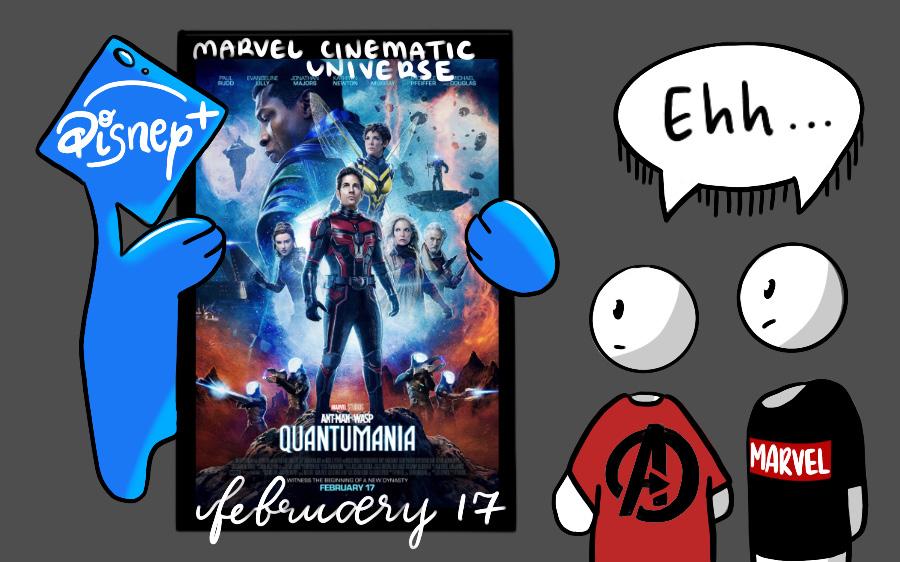 BY MAYA KORNYEYEVA mkornyeyeva@ucdavis.edu
BY MAYA KORNYEYEVA mkornyeyeva@ucdavis.edu
Disclaimer: This article contains spoilers for “WandaVision,” “Loki” and “The Falcon and the Winter Soldier.”
I would argue that the release of the first “Iron Man” was a pivotal moment in the blockbuster film industry. Before then, I had always seen comic books as niche areas of entertainment that the general movie-goer wasn’t particularly interested in. Fast forward to 2019, the epic fourth and final installation of the Avengers series hit the screens and garnered a whopping $2.8 billion at the box office.
People who had never seen a single Marvel movie came to watch, as did fans of all ages. It seemed that everyone was packing into the theaters to view this cinematic spectacle, and boy did it not disappoint. With a 94% Rotten Tomatoes Tomatometer score and an audience score of 90%, “Avengers: Endgame” was a triumph of superb acting and state-of-the-art CGI. I, like many others, expected Marvel to only get better from there — with graphic imaging being revolutionized practically every day and a breadth of new characters to introduce, up was seemingly the only direction to go.
Then Disney+ launched. At first glance, this was a Disney fan’s dream; the entire collection of Disney animated movies, the Marvel Cinematic Universe (MCU), Star Wars and National Geographic were at their fingertips. Take another look, and the motivations behind such a development also become apparent — money, of course. An online streaming platform seemed like the perfect place to launch a brand new image of the MCU as an interconnected world of behind-thescenes documentaries, cartoons and shows, and make some money off of viewers in the process. Hint: this is where it all goes downhill.
I don’t deny that I was excited for the first Marvel TV series, “WandaVision,” as well as the “Loki” series and “What If?” I was genuinely curious as to how Marvel would adapt their storytelling to fit an episodic format. For me, though, watching “WandaVision” was a bit of a mixed experience. I loved the way the directors and producers adapted a sitcom style to depict an unnerving alternate universe of Wanda’s own creation — the motifs used to deal

with loss and derealization were unique and refreshing. What wasn’t was the introduction of Agatha as a villain and witchcraft as a legitimate part of the MCU. And it didn’t stop there. With “Loki” came the idea that the allimportant infinity stones were being used as paperweights at the TVA, and “The Falcon and the Winter Soldier” introduced a plot of a strange and illogical post-blip world. Over the next several years, Disney funded more and more shows that quickly oversaturated the MCU and lowered the quality standard for their films.
Suddenly, I stopped being interested in their new shows, mainly because it became increasingly difficult to keep up with all of the new Phase Four installations. It was as if the tracks that the “Marvel Train” was riding on suddenly lifted off the ground and split into a thousand different directions. There was also a significant dip in the quality and directing of Marvel movie sequels; a few prime examples include “Thor: Love and Thunder” and “Ant Man: Quantumania,” which garnered 63% and 47% Rotten Tomato Tomatometer scores respectively.
Now I, and many original Marvel fans, are longing for a return to the preDisney+ era. The nostalgia and character building of the first original “Captain America,” “The Avengers” and “Iron Man” series created movie experiences that deeply resonated with viewers and presented them with exciting visuals and well-written films. More importantly, I can contentedly watch the Phase One and Two Marvel movies over and over again, never getting bored.
While “Black Panther: Wakanda Forever” has given me hope that a return to such an MCU is not an unattainable dream, that hope remains slim as long as Disney’s profit-oriented approach holds the reins. What Marvel Studios desperately needs is to stop stretching its budget thin and instead dedicate sufficient resources, time and talent to developing high-quality movies that don’t muddle and confuse preestablished storylines. Fans are already turning their backs; now is the time to recapture their interest and stop them from walking away for good.
Disclaimer: The views and opinions expressed by individual columnists belong to the columnists alone and do not necessarily indicate the views and opinions
THE CALIFORNIA AGGIE THURSDAY, MARCH 9, 2023 | 5
EDITORIAL
views and opinions expressed by individual columnists belong to the columnists alone and do not necessarily indicate the views and opinions held by The California Aggie.
The
MAYA KORNYEYEVA / AGGIE
MIRANDA LEE / AGGIE
ARTS & CULTURE
Review: Charlotte Wells encapsulates the lens
through
which we view parental figures in ‘Aftersun’
The nostalgic cinematography allows the audience to see the innate complexity of parent-child relationships
BY ANA BACH arts@theaggie.org
“Aftersun,” the directorial debut from Charlotte Wells, is an A24produced film that premiered in theaters on Oct. 21 of last year. Frankie Corio plays narrator Sophie, through whom we see a story almost entirely made up of flashbacks of a vacation to Turkey she took with her father Calum when she was 11. The film is shot through Sophie’s perspective as an adult, looking back through camera recordings of the trip, which brings up recollections of the vacations’s niche details and experiences. Throughout, she reflects on what her father was going through at that time while she experiences similar feelings in her adult years.

While the film is ambiguous, providing little context about Sophie and Calum’s relationship outside of the trip, the mental health struggles that Calum is dealing with or what happened to him when they returned from Turkey, but that background isn’t really necessary. If anything, the vagueness of the film makes the underlying themes
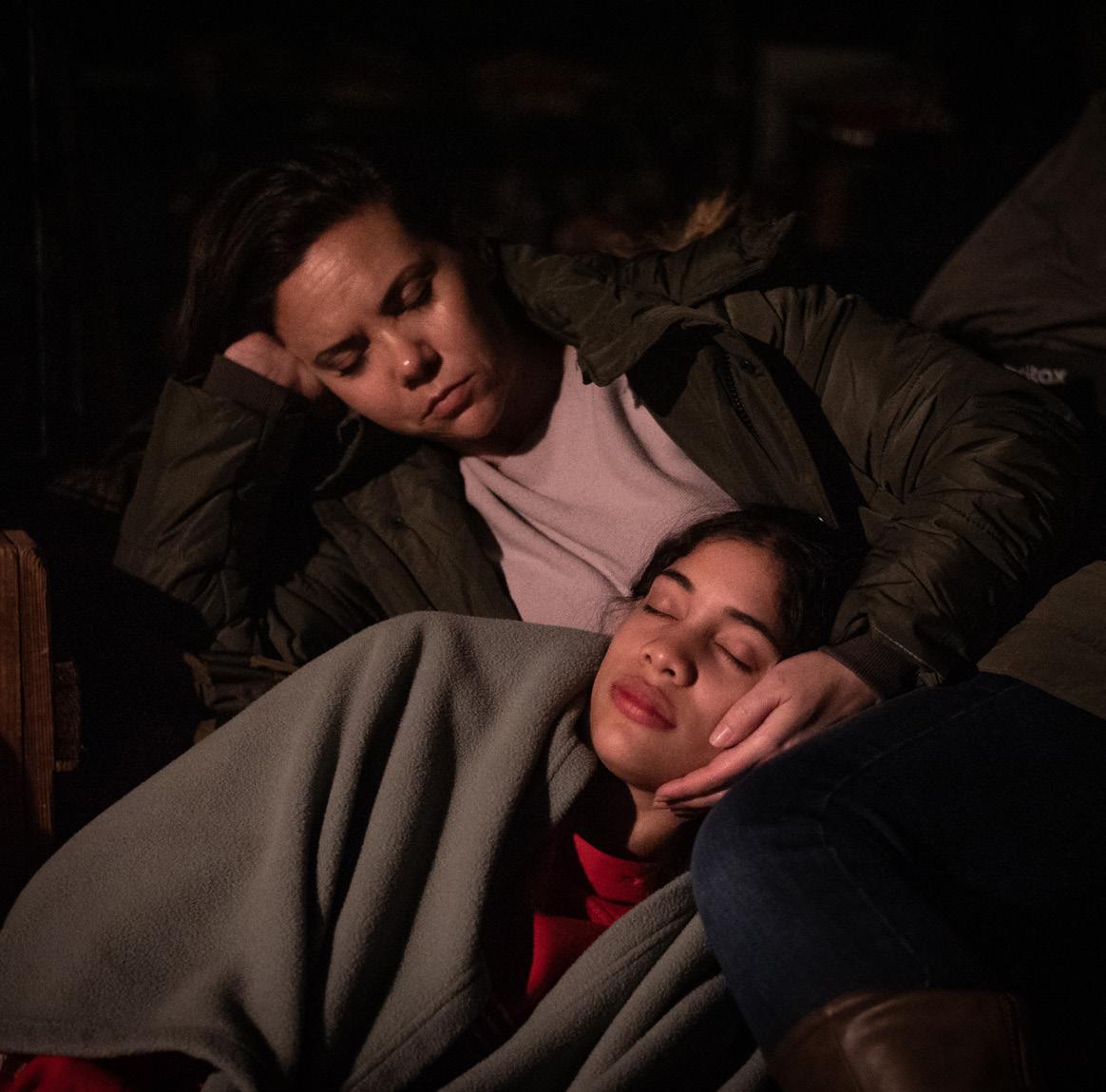
more malleable to anyone watching, allowing viewers to fill in the gaps and add anecdotes to find personal relevance within the storyline.
The film does a beautiful job of capturing nostalgia through texture and composition. The natural light, color scheme and hazy nature of the old camcorder clips give the film its special backbone and unique character. Even the more simple moments captured on screen have an extreme beauty about them that resembles the way memories imprint in our minds; specific but mundane moments, like skin glistening in the sunlight or the feeling of someone you love’s hand applying lotion to your sunburn, turn into emotionally rich memories.
The distinct texture in this movie produces the foundation for the dichotomy between the moments captured on camera and the memories that Sophie remembers. The texture that comes from memory is so vivid as the saturation comes more to life, especially
Adam Moore and Victoria Tzykun designed the interactive performance as a testament to stability
since Sophie is reliving these experiences that she formed as a child. The moments of flashback have ab undertone of euphoria, created by warm-toned light and increased saturation. The filming and editing styles contribute significantly to the plot of the movie — so much so that it is just as valuable as the characters and their dialogue.
Throughout the film, it is made clear that Calum is battling depression and other emotional turmoil. One part specifically shows an 11-year-old Sophie recording him and asking where he thought he would be 20 years down the line when he was her age. At first, he is hesitant to respond but eventually admits that he is surprised he even made it to 30 and struggles to see himself at 40.
The film also shows the complex relationship that a father like Calum has with a child who expresses negative emotion. In a moment where the two of them are sitting in a hotel room, Calum asks Sophie how she feels after the day. She says, “I don’t know. Don’t you ever just feel like you’ve just done a whole amazing day, and then you come home and feel tired and down and feel like your bones don’t work? They’re just tired, and everything is tired. Like you’re sinking.” Upon hearing this, Calum spits at the mirror in front of him. He is hypersensitive to the idea that his daughter is, or might in the future, experience the same emotional turmoil he often does.
Another important moment in the movie occurs when Sophie and Calum are talking by the pool. Sophie says, “I look up to the sky, and if I can see the sun, then I think about the fact that we can both see the sun. So, even though we’re not actually in the same place, and we’re not actually together, we kind of are in a way, you know? Like we’re both underneath the same sky, so we’re kind of together.”
The sun seems to be the thing that unites them most in their current relationship, but it is also one of the farthest things from all of us. This moment alludes to the fact that even though Sophie and her father no longer have a relationship in present day, they are still connected.
“Aftersun” reminds younger that parents are also experiencing a phase of life for the first time and helps them to feel empathy and understanding for parental figures. There is an inner child that perhaps never leaves us, even as we age into adulthood, and I think it is extremely powerful to see that portrayed on screen. Wells has created a movie that reminds us that just as we all live under the same sun, we likely share many of the same experiences.
BY CLARA FISCHER arts@theaggie.org
Prompted by the ongoing war in Ukraine, the UC Davis Department of Theatre and Dance presents “REFUGE – an immersive theatrical installation.”
The performance, created by Granada Artists-in-Residence David Adam Moore and Victoria Tzykun, is composed of various scenes depicting life in a war-torn country, and the many complex emotions that come with this. Moore emphasized the more general theme of the performance, stating that “... the focus of this work [is pointed] not on the depiction of the current situation, but on a central question raised by the Russian invasion of Ukraine: What is home?”
The setup of the performance contributes significantly to this theme, as the audience is transported into the setting itself. Viewers are ushered through hallways and across the main stage to view a series of scenes meant to emulate the experiences of refugees and others affected by wartime. At various points, actors even weave through the audience and break the fourth wall to interact with the crowd. Through these tactics, viewers feel intimately connected with the work and can begin to grasp the gravity of what is being represented.
Of course, this innovative screenplay wouldn’t be as impactful as it is without convincing performances by the cast. As Moore states, “[Working with a live situation] brings a deeper level of responsibility and engagement for student performers tasked with creating characters who embody the experience of millions of refugees from many times
and places throughout human history.”
There is a lot of talent on display during this production, and it aids in bringing across the highly charged subject matter. The actors, singers and stagehands accountable for transporting the audience into the scenes being presented all do a fantastic job at their respective roles.
On top of impactful performances by the cast, the innovative stage design adds dimension to the experience. When first entering the set, audience members are guided through a long, dark hallway with various everyday items suspended overhead while actors recite testimonies about their meanings from behind the curtains. This gives the production a chilling undertone from the start and sets up the immersive aspect from the beginning. Other impressive design elements include a bed that actors switch in and out of seemingly out of thin air and a symbolically choreographed dance routine utilizing floating beams of light.
It’s abundantly clear that this difficult subject matter was handled with care and concern.; from the themes to the execution by cast and crew, this show comes at an opportune moment in modern history to give thought to universal questions concerning belonging, displacement and what makes a place a home.
“REFUGE” will be playing March 2- 5 and March 9-10 in the Main Theater at Wright Hall, with showtimes at 6:30 p.m. and 8:30 p.m. Tickets are available on the Department of Theatre and Dance’s website.
Commentary: A case for cleaning your room
Your room can be a reflection of who you are
BY RUMA POUDELL arts@theaggie.org
As college students, many of us are frequently moving into new spaces. Whether it be a dorm room, apartment or house, these areas often become reflections of who we are and where our headspace is.
Regardless of your living situation, one piece of advice that can lead to healthier, more successful days is making your bed first thing in the morning. While it’s a simple habit, it holds value. Cleaning up your room and leaving less clutter promotes a clearer mental framework for your conscious to reside in as you physically reside in your room.
If you’re surrounded by mess, it’s most likely going to leave you feeling a bit antsy. This can bleed into other areas of your life, making you less productive or functional. And it goes the other way around too; if your headspace and organizational skills are a bit out of tune, it may manifest into the physical realm as a messier room. So although your mom probably isn’t reminding you to clean your room anymore, she might have been onto something, and it’s a good idea to do so for your own sake.
After cleaning up, decorating can be a fun, affordable way to bring joy to your space and show your style. Nesting your room is an extremely personal and therapeutic process; it is also why each of our rooms is unique, despite being constructed of similar walls and floors.
For example, I love my cousin’s room arrangement. It features green bedding, wooden and gold decorations, a swing and white furniture. Despite how much I like her decorations and set up, I could never see myself living in
it because it’s so different from me and my personality. While her decoration is simple and dainty, my room is way moodier. I have dark brown and black furniture, artwork and memorobelia like bus tickets covering my walls, colorful decorations and many plants.
If you don’t know where to start in your decorating, there are lots of existing styles which you can draw inspiration from.
One popular style among Gen-Z is bohemian decoration, more commonly known as “boho.” Associated with freespirited artistic movements and dating all the way back to the 1800s in France, modern variations of this style includes lots of patterns, greenery and wood accents.
Specific popular decor items that can be found in many younger people’s spaces include LED color-changing strip lights that you can stick to the corners of your walls, expressive tapestries and lots of plants. Candles are also a popular way to add some sensual, pleasant-smelling elements that double as visual stimuli.
Places like Amazon, Target and Ikea, as well as local thrift stores sell a wide variety of decorations at inexpensive prices, and lots of decor can actually be crafted, so decorating your room to your own personal taste is possible to do at a relatively low cost.

In the process of cleaning and decorating your room, you may even find a creative outlet or way to express yourself to visiting guests. Keep your room tidy for your own sake — and have fun with decorations while your’re at it.
LIU / AGGIE
KELLIE
6 | THURSDAY, MARCH 9, 2023 THE CALIFORNIA AGGIE
Theatrical release poster for Aftersun. (Courtesy of A24 / fair use)
‘REFUGE’ highlights a universal need for belonging
David
Danika Sudik and Karianyelis Rivas Navarro rest in shelter in “REFUGE.” (Katherine Hung / Courtesy)
The Arts Desk’s weekly picks for music, movies and more
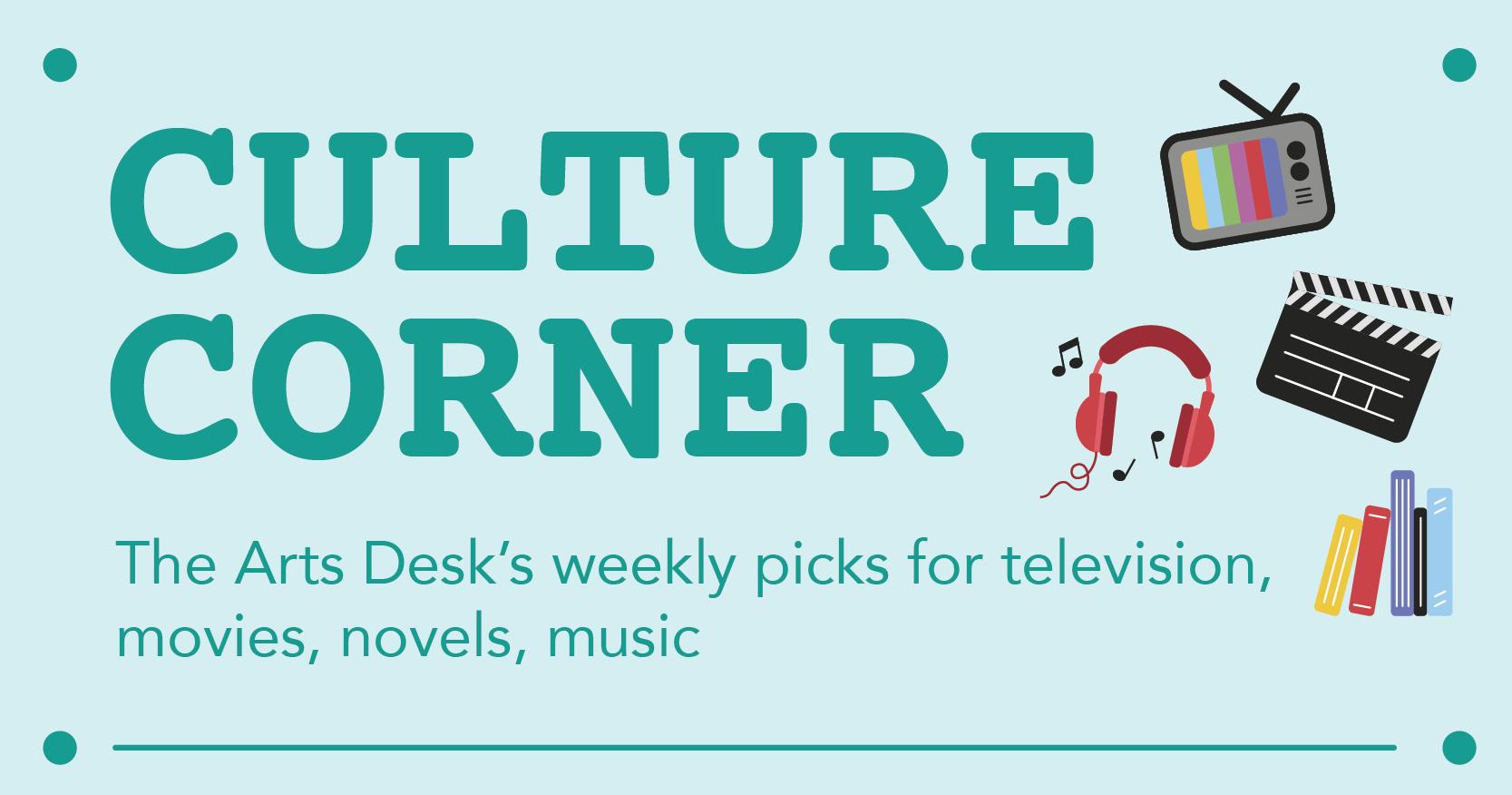
 BY CHRIS PONCE arts@theaggie.org
BY CHRIS PONCE arts@theaggie.org
Commentary: When did we begin to overcomplicate writing?
Writing should aim to be understood by as many people as possible — not sound “advanced”
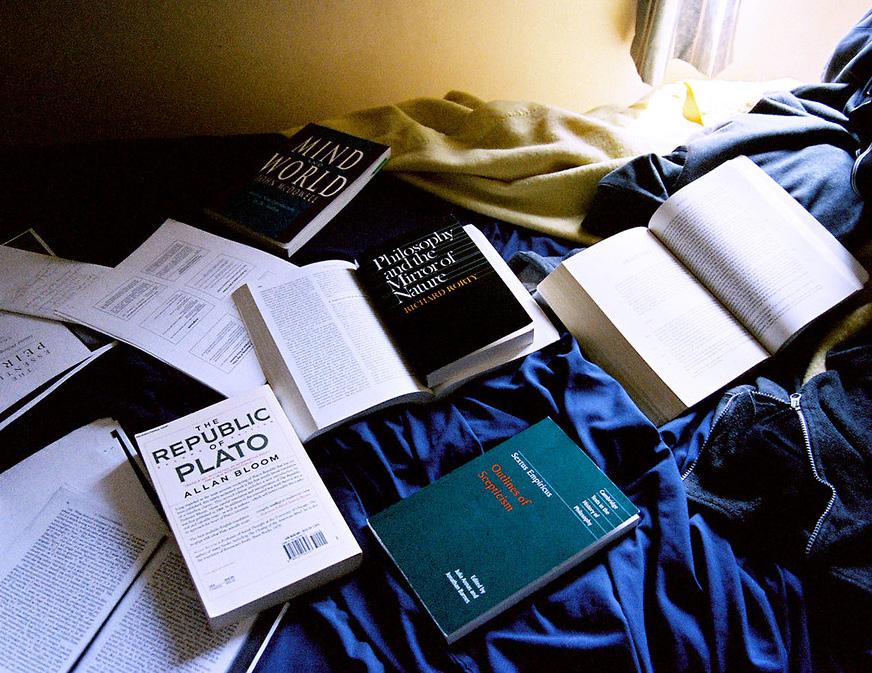 BY SARAH HAN arts@theaggie.org
BY SARAH HAN arts@theaggie.org
Song: “Kids” by Current Joys (2020)
“Kids” is a song that will remind you of the youthful cluelessness we have all experienced (and might still be experiencing). It’s a touching perspective about the mistakes we make as kids. Instead of looking at adolescence through a critical lens, this song embraces the messy imaginative spirit of being a kid. It’s perfect to throw on during a car ride with friends, walking around campus with your headphones on or even just to unwind and relax to. If you like this song, I recommend listening to everything else Current Joys has to offer.
Book: “Wild: From Lost to Found on the Pacific Crest Trail” by Cheryl Strayed (2012)
Truth be told, I have been wanting an excuse to talk about this book since I finished it. In fact, this might be a major reason for me taking over Culture
Corner this week (that and my impeccable taste, of course.) But if my recommendation isn’t reason enough for you to pick up a copy of “Wild,” Strayed’s clear and easy-to-follow writing should be. Her style is welcoming for new readers and bookworms alike. “Wild” isn’t your typical hiking memoir either; instead, Strayed vulnerably tells the story of overcoming and accepting grief, tragedy and addiction. As Strayed recounts the story of her 1,000+ mile trek on the Pacific Crest Trail, she beautifully reflects on her life, accomplishments and, perhaps most interestingly, her mistakes. Her writing is so engaging that as you begin turning the pages of the book, you feel as if you are walking by her side on the trail — every step of the way.
TV Show: “The Last of Us” (2023)
Maybe it’s because of the Pedro Pascal thirst-trap TikTok edits on your “For You” page or because it’s currently one of HBO’s most-streamed shows, but either way, you are likely familiar with “The Last of Us.” The popularity of the show is well deserved, so if you haven’t had the chance to watch it yet, I hope this serves as a final push for you to do so. While “The Last of Us” is another zombie apocalypse show on the surface, the heart of the story is about what makes survival worthwhile in the first place. Performances by Bella Ramsey and Pedro Pascal bring the beloved characters from the video game that the show is based on to life. With only a couple of episodes remaining, now is the perfect time to binge the series (and play the original game while you’re at it).

Movie: “Everything Everywhere All at Once” dir. by Daniel Kwan and Daniel Scheinert (2022)
Wow, just wow. Where do I even start with this one? There aren’t many movies like “Everything Everywhere All at Once,” which manages to tackle the concept of the multiverse through both philosophical and comedic lenses. But beyond being a philosophical trip through the multiverse, this movie is about family and the things we assign meaning to. You’d expect a movie like this to be full of dread and leave you feeling empty, but the beauty of the story is its portrayal of joy. The takeaway of “Everything Everywhere All at Once” is not that everything is meaningless; instead, the takeaway is that we get to decide what has meaning for us. The cinematography and editing are unmatched, and even more impressive considering how small the crew was and how quickly they filmed the movie. With the Oscars approaching, you’ll be hearing more about this movie if you hadn’t already, and luckily, the Davis Varsity Theatre is still showing it, so it’s not too late to see it on the big screen. You won’t regret seeing “Everything Everywhere All at Once,” and I’m willing to bet that once you do watch it, you won’t be able to shut up about it either.
When looking back at books we read as children, the writing feels dramatically simple. The sentences are easily understandable by children and adults alike. On the contrary, research papers seem to be inflated with advanced vocabulary and technical jargon, some of which feel unnecessary.

Indeed, the type of audience has to do with this difference: children’s books are tailored towards younger audiences who may have a limited vocabulary compared to adults. Adults, on the other hand, have a vast pool of knowledge that enables them to understand more complex pieces of writing. However, while some pieces require more nuanced vocabulary, some seem to employ this language for no other reason than sounding advanced.
Take “I ravenously scarfed down food with unmeasurable tenacity,” for example. This was one of the sentences I wrote for a paper in my class. A child, unless they can understand these words, probably cannot grasp the message right away. Admittedly, it takes some time for me to dissect all the words and figure out what this sentence means.
A clearer way of sending my message across would be to write “I was really hungry.” Indeed, this sacrifices some of the imagery communicated in the previous version, but it succeeds in bringing the message across without confusion.
Imagery, detailed language or another literary tool should not be the first priority when writing, unless you know for sure that the audience will be able to fully understand it. Instead, communicating your message to as many people as possible should be the number one goal. Knowledge is a powerful tool, especially in today’s

age of disinformation, so making sure that the largest number of people can grasp the meaning of your written communication is more important now than ever.
Of course, this does not mean that you should always write in the simplest way; there are times when it’s preferred to write with hyper-descriptive words. In fact, I think “advanced” words are suitable when you are describing a setting or environment. For example, a journalism article that features an expert may require more technical language to extensively and saliently tell the reader what the topic is about. The point is more that I don’t think you should overcomplicate your writing for the sake of appearing “smarter.”
For example, “the dark, gloomy sky” can probably reach a wider audience than “the night was dark as obsidian.” For one, people might not know that “obsidian” is a dark and opaque volcanic rock. And while this description definitely intensifies the darkness of the sky, that message might not get across to most people, whereas “the dark, gloomy sky” might be more widely understood because all the words are more commonly known and understood.
I think a good rule of thumb when writing your essays, research papers or even lighthearted blogs is to ask yourself: could a five-year-old understand my writing? Or if that seems too elementary for the topic: could someone who knows nothing about the subject I am writing about grasp the message? These two questions can challenge you to let the message shine rather than the actual words. How do you think I did in sending my message across?
Commentary: Reduce waste by ‘shopping your closet’

The philosophy behind returning to what is already hanging in your closet before you go thrifting
BY ADHITHI ANJALI arts@theaggie.org
In the effort to create a more sustainable world, many people have made a definitive attempt to turn away from fast fashion as a means of achieving their stylistic aspirations. As the “#ThriftTok” tag on TikTok and its over two billion views convey, more and more people are seeing thrifting as a way to meet their needs and participate less in fast fashion consumerism.
But, exactly how is thrifting challenging a consumerist desire to acquire new clothing in order to keep up with increasingly rapid fashion cycles? According to a 2022 “Resale Report” conducted by ThreadUp, a popular and fast-growing resale site, the U.S. secondhand market is expected to reach $82 billion by 2026. This rapid expansion of the secondhand market shows that though thrifting may address the labor and environmental concerns of consumer culture, it will not solve the inherent problem of overconsumption.
Turning back to that old adage, “Reduce, Reuse, Recycle,” thrifting conquers the latter two, but the first might be better addressed by reforming your own habits. This is where the idea of “shopping your closet” might come in as a useful philosophy — fostering both environmental awareness and your own creative forces.
Essentially, the idea of “shopping your closet” is about putting the clothes already in your closet to new use. The main purpose is to reduce consumption and challenge the desire to purchase a new piece of clothing, whether it comes from Depop or a department store.
Instead, you may find outfits or a style that you want to explore and look to your closet to find pieces that can capture the essence of that inspiration. Shopping your closet is a mindset that encourages creativity not driven by the new, but instead by what you thought was old.
Sarah Pando, a fourth-year environmental policy analysis and planning major, works as the co-unit director at the Aggie Reuse Store. Pando reimagines one piece of clothing as a myriad of others, whether that means cutting it up, screen printing it, patching it or just wearing it in an unconventional way.
“When I see a piece of clothing, I don’t just see one way of wearing it, I see multiple,” Pando said. “This pushes me to repurpose the clothes that I’m not wearing. There are so many microtrends, what’s ‘in’ and ‘out’ changes so fast.”
By shopping your closet, you can create a personally timeless wardrobe that fits your needs, outside of the world of fashion cycles and microtrends. By pulling out those old clothes, you can remind yourself of previous versions of style and see how they can be incorporated into your own everevolving definition of yourself.
Beyond the creative aspect, it should be recognized that to shop and dress sustainably ultimately means reducing our consumption. Pando explained that “another issue is that people think thrifting is the solution, but we still have textile waste.”
Only 14.5% of clothes in the U.S. are recycled or reused, and the rest contribute to landfill waste or are exported to other countries. Even of clothing donated to thrift stores, upwards of 80% of donated clothing is left unsold according to Maxine Bédat, author of “Unraveled: The Life and Death of a Garment.”
Thrift stores are not an unproblematic dumping ground for fast fashion excess. While they serve an incredibly important purpose in extending the life of already-in-use garments, in order to target the issues posed by the fast fashion industry, one of our primary aims should be
THE CALIFORNIA AGGIE THURSDAY, MARCH 9, 2023 | 7
KELLIE LIU / AGGIE
to reduce
This can have far-reaching effects, from limiting environmental pollution and textile waste to labor violations. Though replacing a worn item or even treating yourself to something new is sometimes necessary, before you make a purchase, try to ask yourself if you can find a similar piece in your existing wardrobe. Ideally, shopping your closet will remind you of the clothes that you might have forgotten at the bottom of the pile and prompt you to experiment before you feel the need to buy.
all consumption.
Multiple philosophy text books scattered on a bed. (Courtesy of Erunion / Creative Commons, CC BY 2.0)
Students concerned about lack of street lighting in Davis
UC Davis students weigh in on whether the city should expand outdoor nighttime lighting
BY KACEY CHAN features@theaggie.org
Despite Davis’s reputation as a safe city, UC Davis students have concerns about how poorly lit many streets are at night. Given the rainy weather over the past few months, many students say their worries have only intensified.
Hanni Sung, a second-year global disease biology major, pointed to many areas on the UC Davis campus where she feels it is hard to see in the dark.
“There’s definitely a lot of unlit places, like the Arboretum or Shields Library,” Sung said. “A lot of roads and bike pathways, too, like Sprocket Bikeway, feel quite scary at night.”
Many students who often stay late on campus feel unsafe at night due to inadequate street lighting. Sung said that it feels dangerous walking to the bus terminals to make her way home after dark.
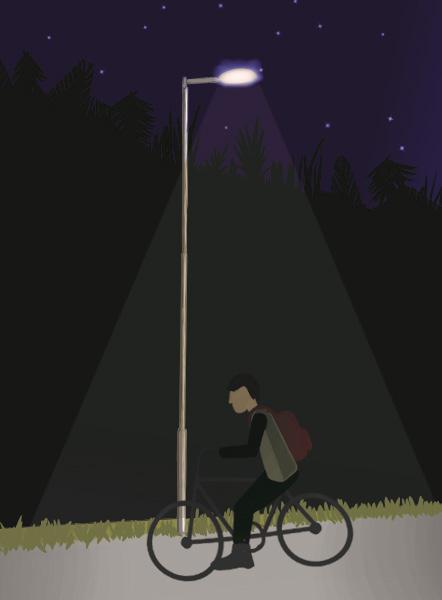
Makenna Yokoyama, a second-year communication major, agreed that the Memorial Union bus terminal is very dark at night.
“There are some smaller areas of the MU that are really unlit,” Yokoyama said. “Whenever I leave basketball practice at night to wait for the buses, it’s way too dark.”
Most of the student body lives offcampus and many rely on walking, biking and public transportation to get around campus and the surrounding
areas. For those who do not have cars, traveling back to their homes from campus at night can feel really unsafe.
Alyssa Enriquez, a second-year linguistics major, said the lack of lighting in the city of Davis also makes it difficult to navigate in the dark.
“Literally all of the sidewalks and walkways along Anderson [Road] are dark at night,” Enriquez said. “Most surrounding areas by apartment complexes I’ve been to like Arlington Farm in West Davis or Temescal in North Davis are incredibly dark to get to at night.”
Enriquez said that she even had to memorize when she should pull the bus cord to signal the driver to stop on her commute home at night.
“There is only one bright landmark in the neighborhood, so I’ve learned to time it from there,” Enriquez said. Another key concern for students is the downtown area.
“Some less popular streets downtown have almost no street lights,” said Amy Zhang, a second-year electrical engineering major. “The whole area next to Mishka’s Cafe is quite dark at night when compared to the rest of downtown.”
According to the Pedestrian and Bicycle Information Center, a site funded by the U.S. Department of Transportation, street lighting is important for improving pedestrian visibility and personal security, increasing safety for both pedestrians
and drivers. As Davis is famous for its reputation for bicycle safety, expanding nighttime lighting would relieve the concerns of students who bike home at night.
A possible reason for the lack of lighting might be to prevent light pollution or “light spill” — a concept which refers to the “presence of unwanted or misdirected light,” according to a report from the City of Davis. It goes on to mention that while street lighting is provided, they want to ensure that it does not become a “nuisance” or “diminish the view of the clear night sky […] and disturb wildlife in natural habitat areas.”
Furthermore, the report claims that the city “requires developers to install lights and dedicate them to the city.” Similarly, for areas reported to be darker at night like the Arboretum, implementation of street lighting falls under the purview of school-specific departments like the UC Davis Arboretum and Public Garden.
The variation in responsibility for nighttime lighting may make student concerns about the issue difficult for one institution to address. Street lighting is left under the discretion of different institutions or enterprises and their varied obligations, making it challenging to coordinate a solution. However, many students hope they may see an expansion of outdoor and nighttime lighting throughout Davis in the future.
ASUCD senator pushes for antisemitism education training
ASUCD SB #72, which would require antisemitism training for the ASUCD Senate table, was tabled due to the partisanship of the organization providing the training
BY LILY FREEMAN campus@theaggie.org
ASUCD Senate Bill #72, which would require antisemitism training for the Senate table, according to the bill language, was introduced and subsequently tabled indefinitely at the March 2 Senate meeting. The bill was authored by Senator Jacob Klein, who explained how his experience with antisemitism led to the creation of the bill.
“Antisemitism often comes from well-meaning individuals who do not realize how their language is problematic,” Klein said. “This fundamental lack of awareness results in antisemitic tropes, such as dual loyalty and the misrepresentation of Jewish people, as being too powerful. In my eight weeks as an ASUCD senator, I have faced both of these vile tropes.”
Klein went on to say that he would like to believe that none of this conduct toward him was intentional, and because of this, he believes that the only solution is education. If it had been passed, according to Klein, the training would have required all ASUCD Senate members to attend an hour-and-a-half training that covered topics related to antisemitism. The training would focus on the Jewish identity and experience, historical and contemporary manifestations of antisemitism and antisemitism on college campuses. Prior to the introduction of SB
SPECIALSENATE
FROM PAGE 2
External Vice President Celene
Aridin asked May if the university is planning to turn the ARC into an oncampus voting center again for upcoming elections, and he said that they are. She also expressed complaints about the slow voting process at these centers, to which he said that he is happy to work with
#72 on the Senate floor, according to Klein, the bill was passed by the External Affairs Commission and the Gender and Sexuality Commission. However, the bill was rejected twice by the Ethnic and Cultural Affairs Commission (ECAC).
Gabriel Gaysinsky, a second-year international relations and Middle Eastern/South Asian Studies double major and an ECAC commissioner, was one of two ECAC commissioners who voted in favor of SB #72, out of nine total.
“During public deliberations on the bill, many representatives of student organizations made a slew of libelous and disturbing remarks,” Gaysinsky said. “Student after student belittled the Jewish connection to the land of Israel, claiming it to be simply a colonial construction.”
Gaysinsky also outlined various other occurrences of antisemitism at UC Davis, which he said justifies the necessity for ASUCD antisemitism training.
“The rockets fired [...] towards Israeli civilians were gleefully drawn on the UC Davis quad last month,” Gaysinsky said. “Jewish and Israeli groups on campus have been shouted down and verbally harassed, with our events at times being shut down out of fear for our safety. This all works in tandem with [...] the banners displaying antisemitic messages in the summer and swastika graffiti in the fall to make campus an extremely unsafe space for its Jewish students.”
Once SB #72 reached the Senate floor, it was tabled. According to Klein,
the county to try to make things more efficient this year.
Next, May answered a question about the TPUSA event coming up, saying that while he of course supports protests on campus, there are also alternative forms of expressing disagreement with the organization’s views that students can take advantage of.
“I think it will be a very effective and compelling message if that speaker comes and speaks to an empty room,” May said.
“Nothing would please me more.”
Reguerín added that ASUCD could
More than 60 community members publicly oppose bill at March 2 Senate meeting
this was due to unforeseen issues with the organization that was going to run the training, the Academic Engagement Network (AEN).
Interim Senator Shrey Gupta discussed these issues and his reasoning for wanting to table the bill.
“AEN as an organization is not the right choice for UC Davis,” Gupta said. “I don’t have the specifics on hand, but it was revealed they were tied to or receiving funding from the Israeli government. Working with an organization with such a partisan stance in world politics opposes the beliefs of our Palestinian students, which wouldn’t be a very good thing.”
Gupta outlined that the goal now is to find an organization to conduct the training that does not take a defined stance on the matter, in order to present all perspectives.
Now that SB #72 has been deliberated on and tabled, Klein said that he is currently working on resubmitting the bill with a different training organization. Klein concluded with his final thoughts on the need for antisemitism training through this bill.
“People should be aware of the impact of their words and of what, historically, these sentiments have resulted in,” Klein said. “Ultimately, having an hour-and-a-half training can cover a lot of these nuances and a lot of these miscommunications to make sure that in the future we all have enough of an understanding to move forward together.”
hold hlding alternative programming on the same day and time as the speaker event.

“One approach is to have more expression, more voice, so for me, holding an alternative event is a phenomenal way to do it,” Reguerín said.
May concluded his presentation and left the room. The Senate removed the quarterly reports planned for that night from the agenda and adjourned at 6:51 p.m.
The bill, which would require antisemitism training for the Senate table, received backlash following concerns about anti-Palestinian sentiments held by the organization that would provide the training BY RACHEL GAUER campus@theaggie.org
Note: Some sources are anonymous for the safety of the Palestinian students who commented during the meeting.
Vice President JT Eden called the meeting to order at 6:14 p.m. on Thursday, March 2. Following roll call, he recited the UC Davis Land Acknowledgement.
Next, the Senate heard a presentation from Associate Vice Chancellor Cory Vu. Vu highlighted Aggie Mental Health resources and gave updates regarding the process of hiring new members of their team.
“We have about seven counselors left that we need to hire, but once we get all of them hired I think we will be in very good shape in terms of access here on campus,” Vu said. Vu also spoke about a current project called Health 34, which plans to launch in the fall. Vu is working with the UC Davis Fire Chief Nathan Trauernicht to create an emergency service that is specific to mental health crises.
“Imagine if you have a friend or roommate or anyone that you know who is in distress,” Vu said. “Instead of calling 911 for the police to come and assist, you can call a seven-digit number, and when you call them, a team will arrive which will consist of paramedics, EMT students trained by the fire department and a nurse navigator.”
Next, the Senate heard a presentation from recently elected Davis City Councilmember Bapu Vaitla. Vatila responded to Senator Stephen Fujimoto’s questioning regarding how the city can improve the current housing crisis.
“We will do our best as a city to ask the university for more, but also we have very little leverage,” Vaitla said. “We gain leverage if students organize themselves and ask for the same things — if they ask the city and ask UC Davis.”
Next, the Senate confirmed three new STEM committee members: second-year human development major Julia Miller, first-year data science major Pearl Vishen and second year Wildlife, Fish, and Conservation major Grace Gabel. After questions from members of the Senate, all three members were confirmed.
Following the confirmations, Chairperson Yoanna Soliman presented the STEM quarterly report. The committee is currently working on onboarding its new vice chairperson by the end of this quarter.
Next, the Senate heard the Disability Rights Advocacy Committee’s (DRAC) quarterly report, presented by Chairperson Ryan Manriquez. Manriquez spoke about new mats that could help accommodate disabilities in areas on campus with uneven ground during outdoor events such as Picnic Day and Sunset Fest.
Next, the Senate heard from the Judicial Council. Chairperson Amanda Clark and the committee’s newest member, fourth-year political science major Gustavo Pichardo Villaseñor, presented their committee’s quarterly report. They discussed the committee’s expectations and reviewed what it does and the tasks it carries out in relation to the Senate’s passage of bills.
Next, the Environmental Policy and Planning Committee gave their quarterly report, presented by Chairperson Mackenzie Field. Field highlighted
the Cool Campus Challenge, is a competition between UC Berkeley and UC Davis that will take place between April 3 and April 28.
“It’s going to be an inter-campus sustainability challenge where participants record their sustainable actions and we will keep track of points,” Field said.
After a short break, the Senate resumed, moving into the introduction of new legislation. Following the introduction, they reviewed the consent calendar. The consent calendar was passed, and SB #74, SB# 78 and SB #82 all passed unanimously without objection.
Next, the Senate discussed SB #72, a bill introduced by Senator Jacob Klein that would require antisemitism training for the Senate table. The bill received widespread criticism, and a letter emerged opposing SB #72 that received almost 300 signatures. Many students and community members who opposed this bill joined the meeting in person and via Zoom.
First, Senator Klein provided his comments surrounding the bill and the backlash it received.
“SB #72 would require the Senate table to attend an antisemitism training conducted by the Academic Engagement Network, or AEM,” Klein said. “The main complaint in the letter is in regards to AEN as an organization. The UC Davis Office of Diversity, Equity and Inclusion (DEI) recommended that we use AEN.”
The Senate then opened the floor to public comments concerning the bill.
First, the current Muslim Student Association president, who is also a former ASUCD senator, shared her perspective on the bill.
“I believe that having antisemitism training for the table is vital and is something that should have been implemented a long time ago,” the student said. “I am concerned, however, with the language in SB #72 in that it identifies AEN as the organization responsible for conducting the training. On its website, AEN takes an explicit stance on the boycott, divestments and sanctions (BDS) movement.”
Next, the Students for Justice in Palestine president outlined the bias they believed is present in the AEN mission statement.
“The organization [...] clearly appears to be more concerned with the efforts of criticizing Israel and Zionism rather than actually combating antisemitism on campus,” the student said. “In total, this organization mentioned Israel seven times, ‘zionist’ twice, and ‘antisemitism’ only once in their entire mission statement.”
The vice president of Students for Justice in Palestine also commented on the views expressed by the executive director of the AEN organization.
“The executive director of AEN, Miriam Elman, is a known zionist advocate who has written for rightwinged platforms,” the student said. “Elman’s bio on the AEN website is replete with her experience oppressing Palestinians and Palestinian activists across the country. There is no mention whatsoever of Elman’s experience fighting antisemitism, making her and her organization unqualified to lead students on this campus to address [antisemitism].
8 | THURSDAY, MARCH 9, 2023 THE CALIFORNIA AGGIE
AGGIE
NATALIE CHENG /
SENATE on 10
Sudoku




Enter digits from 1 to 9 into the blank spaces. Every row, column and 3x3 square must contain each digit. Each Sudoku has a unique solution that can be reached logically without guessing.
Crossword

THURSDAY, MARCH 9, 2023 | 9 THE CALIFORNIA AGGIE
Answer to previous puzzle 3/2/23 r edu c e . r eu s e . r e cycl e . T h e a gg i e Answer to previous puzzle 3/2/23 Scan to upload your completed crossword for the chance to win a prize!
Trader Joe’s Fashion Week
 BY PRISCILA JIMÈNEZ CORRALES vjthen@ucdavis.edu
BY PRISCILA JIMÈNEZ CORRALES vjthen@ucdavis.edu
Bathroom hunting
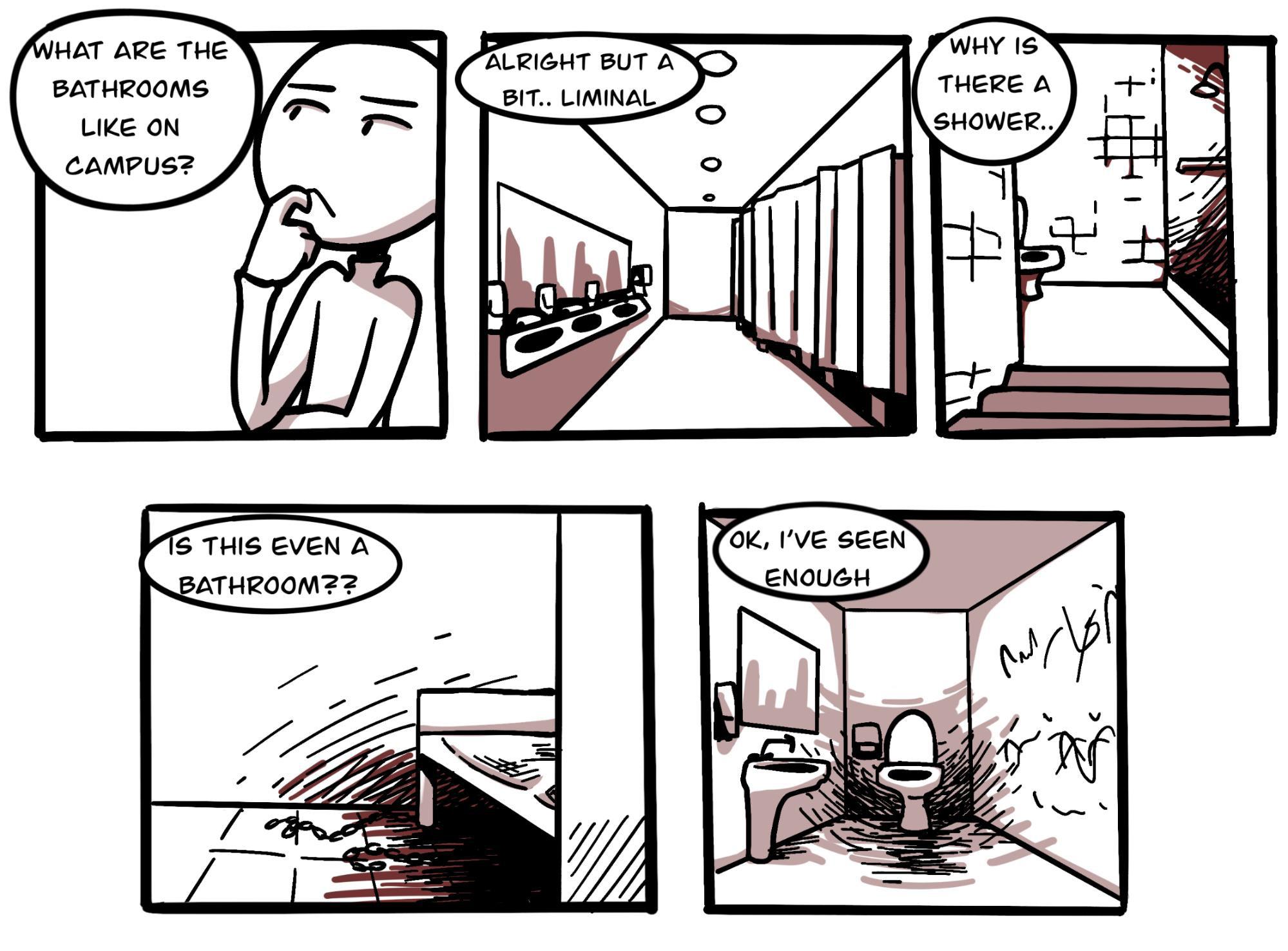 BY LIDYA SHCHERBAKOVA lvshcherbasbpfile@ucdavis.edu
BY LIDYA SHCHERBAKOVA lvshcherbasbpfile@ucdavis.edu
Disclaimer: This cartoon is humor and/or satire, and its content is purely fictional. The story and names of “sources” are fictionalized.
I thought quicksand would be a bigger deal
Looney Tunes failed me
BY CARMEL RAVIV craviv@ucdavis.edu
As a kid, I was always wary of wet sand because I was convinced it would be quicksand. I thought that stepping in it would cause me to start slowly descending into a suffocating death. The worst part about a quicksand death, I thought, would be the waiting. I hate waiting. I would probably tell the sand to hurry up and kill me already.
Wet sand wasn’t the only thing I was cautious of — I was also always on the lookout for skunks, because if one of them sprayed me, I would have to take a tomato sauce bath, and I hate tomatoes.
But then I grew up and realized — just because I saw it on Looney Tunes doesn’t mean it’s going to happen. Likewise, just because my middle school teacher told me to get my act together, because lollygagging isn’t tolerated in high school, doesn’t mean it’s true.
Because then you get my economics teacher. The kind of teacher who talks way too much about his divorce and leaves the classroom during a test to get Starbucks (I hate you Mr. Klark). I ended up learning more about economics from the vending machine and “Clash of Clans.”
Turns out, high school wasn’t as serious as I made it out to be. While some teachers weren’t ideal, they also weren’t Ms. Trunchbull; they didn’t chuck me across the yard if I turned in homework late. I look back now and really wish I didn’t stress out about high school so much.
Even so, I still catch myself feeding those same worries in college. Every time I register for classes, I look at the packed schedule, less-than-ideal discussion times and low “Rate My
Professor” score that are all ensuring I’ll have a stressful and inconvenient quarter.
But then the quarter starts, and it turns out that it’s okay to miss a lecture here and there. And then there’s a friend from my dorm building in my class, so I have someone to mess around with, making the time go by. To top it off, the professor that has hexes on their first born child in the “Rate My Professor” reviews isn’t even all that bad. There’s no point in getting anxious and apprehensive about what’s to come, because once it does, you’ll deal with it head-on and realize you’re more capable than you thought.
It’s easy to make things a bigger deal than they actually are. It’s easy to spend your entire life afraid of quicksand or talking to your crush or doing something you’ve never done before.
It’s important to realize that some things will only bother you as much as you let them. Though there will always be some things you can’t control, you can redirect your energy toward the things that you can control — the things that have value. Let things happen as they happen and trust yourself that you’ll make it work.
So next time you see some wet sand, jump in it, because it won’t kill you. You’re not likely to encounter a skunk anyways, so go ahead and avoid tomato sauce if you really hate it. Life is too short to make everything a big deal.
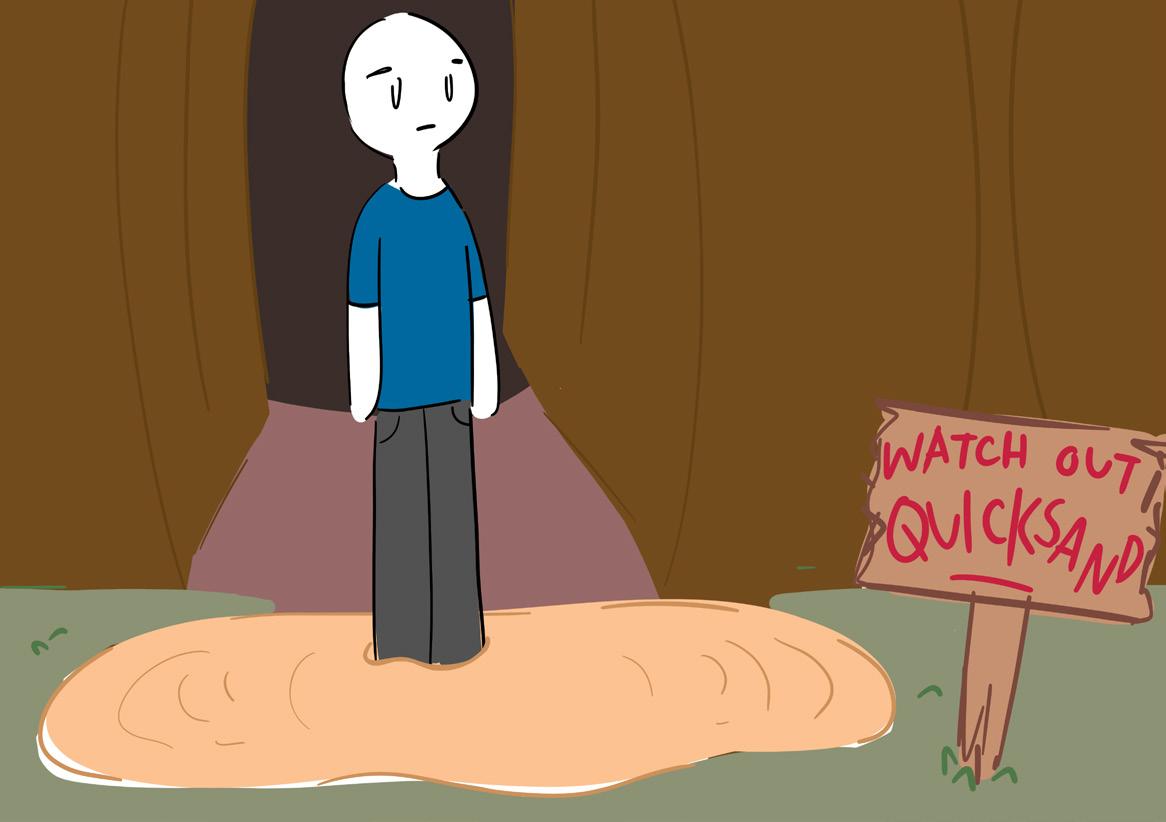
Disclaimer: This article is humor and/or satire, and its content is purely fictional. The story and the names of “sources” are fictionalized.
MIRANDA LEE / AGGIE
BLACKPANTHER
FROM PAGE 3
Bell said she intentionally wanted Seale to come because she hoped it would “reconnect [students] to today’s social justice movement” after the COVID-19 pandemic put a pause on many students’ lives. Bell said she wanted students to feel energized and also remind students about how capable they are of changing the world at any age. When Seale and Newton started the BPP, they were both students at Merritt College. Seale said during the event that he also started a Black History reading group after college which he hosted with about 12 others at the time.
“When the Black Panthers started, they were all in their 20s,” Bell said. “MLK, Bobby and Huey were all right on the other side of college. I thought if they could achieve that at such a young age, how inspiring would it be for our students right now.”
Seale is still an active member in his community and announced his future plans to work on housing inequity in
AGGIEBARBELL
FROM PAGE 3
Ngo gave some advice for people who want to get into lifting but are intimidated by the gym.
“Make your routine at home, so you know what you’re going to do at the gym,” Ngo said. “There’s a lot of great resources online, and even here. Aggie Barbell does a lot of beginner-friendly workshops for people who are interested in learning about lifting.”
Hurtado said joining a powerlifting community like Aggie Barbell provided him with new ways to track improvement in his performance.
“It is also a little fun to get
ALPINESKI
FROM PAGE 3
Wadhwani said she thinks that the most important part of a race is that everyone is comfortable and has as much fun as possible. DASS collectively expressed that they cheer each other on, even when the racing gets tough. Bailey Sokol, a second-year political science and economics double major, said she’s excited to go to nationals with her team and “will always help others try
SENATE FROM PAGE 8
Following the public comments, Senator Zeph Schnelbach voiced his opposition to the bill.
“I cannot endorse a training that I, one, have not seen [...] and two, is conducted by an organization in which the very name has brought an unprecedented amount of students to our meeting tonight,” Schnelbach said.
“We as a table can also not ignore the voices that have been brought to us
questionnaire.
the East Bay, with youth programs as well as grant writing. Bell also reminds us that if “the Black Panther co-founder is still working, the rest of us can not rest on our morals.”
After the event, students in California Hall reflected on the words and the impact Seale’s legacy continues to have on them. Sriram Srinivas, a second-year plant sciences major, said they believe the Black Panther Party is an important part of history.
“So much of our liberation comes from the work and conception that the Black Panther Party created and the work they did,” Srinivas said. “I’m really grateful, and I want to learn more about the work they did, so I can see what I can do now.”
Another student, second-year American studies major Emi Morrujo, said she, as a Chicana student, has a personal connection to the Black Panthers and Bobby Seale.
“A lot of the Chicano movement brought their points and drew from the Black Panther Party,” Morrujo said. “So I feel like a lot of the liberation that I get today in society comes from the Black Panther Party.”
Having Seale come to campus and speak was a historic moment, one
competitive with it,” Hurtado said. “As much as they say to focus on yourself, it is fun to be like, ‘I’m catching up with that guy.’ It’s just fun to move forward because the progress is pretty objective.”
In powerlifting, progress can be seen pretty objectively by increasing weight or repetitions of a certain movement. But Hurtado stressed that though seeing progress is exciting, it is important to remember that is not linear.
“Over the summer, I squatted 500 just for a single, and there was a bit of an accident because the bar slid down my back, and it put a lot of pressure on my left hip,” Hurtado said. “After that, I could hardly squat like 10% of my squat for the rest of the summer. It took a long time to get over, but now I’m doing [500] for sets of eight, so it’s cool to think you don’t stay in one
to improve their racing abilities and always cheer on [her] teammates while racing.” Though teamwork and skill are essential to the DASS team, it is quite an expensive hobby due to all of the equipment and travel necessary to compete. Currently, the team is fundraising through GoFundMe to help send members to nationals. The club’s success at the regional championships is a testament to the dedication and perseverance of these student-athletes. Through hard work, teamwork and love for the sport, they overcame the harsh weather and brought home high scores.
today by the almost 300 people who have signed that letter.”
Next, Senator Klien, the author of SB #72, responded to the comments.
“Based on the overwhelming opinion that I am hearing today, I am very much amenable to changing the [training] to a different organization,” Klein said. “I was under the impression that I was going through the proper channels by consulting with the office of DEI. I appreciate the number of people who have shown up today. I strongly apologize if any of my conduct has offended or hurt anyone.”
Following Klein’s statement, the Senate moved into voting. The Senate
that will be solidified in the minds of many students. As Seale mentioned at the event, there is still more work to be done. Seale said in his speech that students should remember to “love, respect and care for [their] community,” as well as promote change.
“A big part of my life is always trying to reconnect with that era, that generation, to learn from them,” Kwame Hargrove, a first-year history major, said. “Both their successes and failures and how I apply my own conscious of what I think is right or wrong, with political action, social change and things like that.”
It is important to remember that everyone has an obligation to stand up against oppressive forces, according to Bell.
“Folks [should] keep in mind there is work to be done and that we need accomplices to get that work done,” Bell said. “It is not on the Black students to fix the institution. It is not on the Black faculty to fix the institution and the Black staff and administrators, although all of them are working. It is the work of the institution and its entirety — the students, the faculty and the administration.”
place forever.”
Making progress, no matter how big or small, also often translates into confidence, according to Chau.
“Powerlifting has positively impacted my life because it helped me build confidence in myself and my strength by seeing how much progress I’ve made since when I first started,” Chau said. “Powerlifting requires a lot of time and dedication, and it’s very gratifying to see myself stick with it so far.”
For Ngo and many fellow powerlifters, lifting has changed their lives for the better.
“To me, powerlifting makes me realize how strong I really am,” Ngo said. “It’s really turned my life onto a different path.”
But the team’s achievements extend beyond just the race course. For the DASS team, snow sports have the power to bring people together and foster personal growth. Members say that skiing and snowboarding are more than just hobbies; they are passions that they’re willing to work hard for and invest in. With nationals on the horizon, which will be held on Mammoth Mountain in California from March 6 to 11, the team is looking forward to representing UC Davis with pride. With the support of their fellow students and the wider community, they’re sure to achieve great heights.
voted 11-1 to table SB #72 indefinitely, meaning the bill will no longer be considered and an updated bill, recommending a different organization to provide the training, will later be reintroduced.
Next, the Senate introduced SB #73, which would lower the number of signatures required for an UC Davis student to become a candidate in ASUCD elections in order to encourage more competitive elections and higher turnout. The bill passed 7-0-4, and the Senate then moved into open forum. The meeting adjourned at 2:24 a.m. on Friday, March 3.
TABLETSCREENING
FROM PAGE 11
Other participants in the study received treatment as usual, meaning they were screened using clinical judgment without incorporating the questionnaire. Participants were referred to an early psychosis clinic if deemed appropriate by clinicians.
“By doing [the questionnaire]
universally, we are not relying on clinical judgment or the person’s level of comfort in reporting it,” Niendam said. “We’re getting past some of those issues as well as stigma, which means being afraid of disclosing the things that they’re experiencing for fear of judgment by others.”
Results from the study revealed that the detection rate of psychosis spectrum disorders for participants who were actively screened was about doubled. The rate was reported to be 5.6% compared to 2.6% in those who did not take the
Even though the active screening methods provided earlier detection, there was no statistically significant difference in the duration of untreated psychosis. This is most likely due to delayed access to the mental health system in the U.S, according to the study.
Psychosis is typically more severe if it takes longer to treat symptoms after their initial onset, according to previous studies. The National Institute of Mental Health states that approximately 100,000 new cases of psychosis are diagnosed each
year in the U.S. and it typically begins when a person is in their late teens to mid-twenties.
Both Niendam and Carter hope earlier detection of psychosis symptoms through questionnaires like the PQ-B can promote earlier treatment of psychosis before it becomes too severe.
Carter also said that psychosis is not as rare as many people think it is.
“When we look at incidence rates in our community, they can range anywhere from 81-272 [cases] per 100,000 [people],” Niendam said. “A better way
to think about it is that in Sacramento County, over 1,000 people are having the onset of psychosis every year.”
The Early Psychosis Programs at UC Davis Health offer a free online screening survey for those concerned about themselves or others experiencing signs of psychosis.
“Many students, if they’re experiencing these symptoms, are worried about what it means for them,” Niendam said. “There’s hope; don’t be afraid to ask for help if this is something you’re experiencing.”
10 | THURSDAY, MARCH 9, 2023 THE CALIFORNIA AGGIE HUMOR
Disclaimer: This cartoon is humor and/or satire, and its content is purely fictional. The story and names of “sources” are fictionalized.
Double trouble: climate change and deforestation imperil the mammals of the Amazon
A combination of disruptive ecosystem factors could lead to savannization
BY LILLY ACKERMAN science@theaggie.org
A new study from UC Davis has found that deforestation and climate change in the Amazon Rainforest will have negative effects on a large portion of the region’s terrestrial mammal species. According to the study, ecosystem disruption in the Amazon will lead to increased savannization along its southern and eastern borders in the future. Savannization refers to the conversion of forest habitats into open plains.
“In the largest tropical forest on Earth, the Amazon, rising temperatures and lengthening of droughts alone could jeopardize ecosystem integrity and lead to expansion of tropical savannahs,” the study reads.
Daniel Rocha, the lead author of the study who researched this phenomenon while getting his Ph.D. at UC Davis, explained why habitats that are converted from forest to “cerrado,” or savannah, through savannization are less able to support life than natural plains.
“These open habitats will resemble cerrado areas, but without the associated biodiversity, because it is the result of a forest degradation process,” Rocha said via email. “Deforestation, uncontrolled fires, selective logging and other direct forest degradation factors act in synergy with climate change and accelerate the ‘savannization’ of Amazon forest.”
The study focused on savannization’s effects on medium to large terrestrial mammals, including peccaries, jaguars and pumas, in the southern Amazon. Some of the mammals studied are generalists, meaning they could live in forest or savannah habitats, while others are exclusively forest- or savannah-dwelling species.
The authors used camera trap surveys to assess the mammals’ habitat and to determine how each species responded to nearby savannah habitats.
Rocha found that savannization and deforestation were expected to impact forestdwelling mammals. However, somewhat unexpectedly, analysis of the generalist species also showed an impact.
“Surprisingly, most habitat generalist species (i.e., able to use both forest and cerrado) prefer to use forested areas when they have both habitats available,” Rocha said. “This indicates that to some extent they will also be affected by future ‘savannization’ in the Amazon.”
This finding contributed to the conclusion that the majority of the southern Amazon’s mammals are expected to be negatively impacted by savannization. The only species that showed a neutral or positive response to savannization were those that already exclusively inhabiting savannah habitats.
“Some cerrado-specialist mammals will probably benefit from [savannization], like the pampas deer,” Rocha said. “But overall, forest associated and generalist species will be exposed to non-preferable habitat, which can lead to lower survival rates, smaller population sizes and reduction in species distribution range.”

The results of this study reveal a critical risk for the mammals of the Amazon rainforest, the largest biome in Brazil and an important part of the global ecosystem. Combinations of climate change and human-induced deforestation make conservation a more challenging issue for the southern Brazilian Amazon, according to the study.
“If climate-driven savannization causes many of these species to lose access to preferred habitat, this will reduce the ability of protected areas to safeguard wildlife populations,” Rocha said. “The results of this study suggest that these potential effects should be considered when assessing potential climate change effects on these species.”
A 21-question survey doubles detection rate of psychosis symptoms
The UC Davis Health study showed significant improvement in the detection of psychosis compared to those screened using only clinical judgment
BY KATIE HELLMAN science@theaggie.org
In a recent study conducted by UC Davis Health and published in the Journal of the American Medical Association (JAMA) Psychiatry, completing a 21-question survey more than doubled the rate at which young people were able to be correctly identified as having an increased risk of psychosis compared to those who did not take the questionnaire prior to their medical visit. Though the survey did not reduce the time between the initial presentation of symptoms and the beginning of treatment, it marked a significant improvement in psychosis detection.
“In this cluster randomized clinical trial, a population-based technology-enhanced screening plus clinician education identified more individuals with psychosis spectrum disorder than clinician education alone,” the study reads.
The study consisted of information from the surveys, which were taken on tablets by people in 10 community clinics and four California school sites. Some individuals were subject to active screening of psychosis symptoms, where people between 12 and 30 years of age filled out the PQ-B (Prodromal Questionnaire, Brief Version) before an appointment with a mental health care provider.
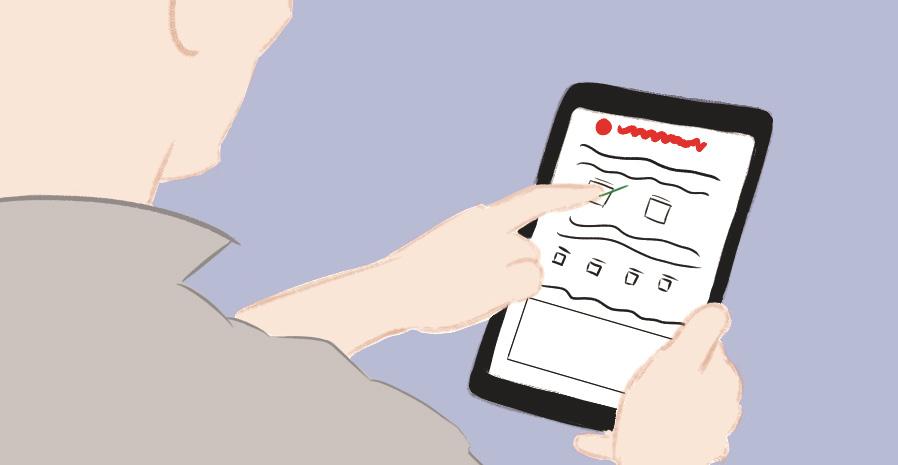
Cameron S. Carter, the senior author of the paper, is a professor of psychiatry and psychology and the director of the UC Davis Health Imaging Research Center and the Behavioral Health Center
for Excellence. He discussed the benefits of applying a questionnaire in the detection of psychosis for patients.
“Screening for suicide risk and depression and anxiety has been very successful in primary care,” Carter said via email. “Very brief screens (e.g. PHQ 9 [Patient Health Questionnaire 9] for depression) have been incorporated into the medical record as part of routine health assessment. I see a future, when we have a slightly more efficient screening tool, when the same approach with a psychosis screen will become standard in mental health and general medical settings.”
Questions that were asked in the questionnaire included, “Do familiar surroundings sometimes seem strange, confusing, threatening or unreal to you?” and “Have you seen things that other people can’t see or don’t seem to see?” If an individual received a score of 20 out of 105 or above on the test, they were offered a referral to an early psychosis clinic.
Tara A. Niendam, the first author of the study and the executive director of the UC Davis Health Early Psychosis Programs, explained the functionality of the questionnaire.
“We can use [the questionnaire] to detect unusual experiences or thoughts that individuals may be having and how much those thoughts distress them,” Niendam said. “That’s really what signals to us as clinicians that something requires attention.”
Inside the California National Primate Research Center at UC-Davis, experimenters cut open monkeys’ skulls and sever part of their spinal cords to inflict damage, even though these kinds of experiments haven’t been useful to humans in the past. Another experimenter has been tearing thousands of baby monkeys away from their mothers for years to study early-life stress. UC-Davis has squandered hundreds of millions of taxpayer dollars, even though public records show a litany of federal animal welfare violations, including monkey escapes, injuries, and deaths.

UC-Davis, close down this relic, and channel your resources into human-relevant, 21st century science instead.

THE CALIFORNIA AGGIE THURSDAY, MARCH 9, 2023 | 11
SCIENCE
AND TECH A
marsh deer
in
the transitional zone between rainforest and savanna (Daniel Rocha / Aggie)
Help us close the California National Primate Research Center. Go to PETA.org/CNPRC CUT FUNDING. NOT OUR SKULLS. ADVERTISEMENT ADVERTISEMENT NATALIE CHENG / AGGIE TABLETSCREENING on 10
MEN’S BASKETBALL
Aggies suffer tough last-minute loss against the Gauchos in conference play
After the loss to UC Santa Barbara, UC Davis closed the season with a big win against Long Beach State securing a spot in the quarterfinals in Henderson, Nevada
BY CAROLYN (CARI) FENN sports@theaggie.org
Despite a strong start by the UC Davis men’s basketball team against UC Santa Barbara at the University Credute Union Center, the Gauchos pulled ahead in the last few minutes to win the game 89-86. This is the fourth game at home this season that the Aggies have lost at home.
Following the altercation that occurred at the Aggies’ last game against the Gauchos, it was expected by many that the game was going to be a matchup to watch. With fans filling most of the seats in the stadium, everyone was eager to see if the Aggies could defeat the Gauchos, who are in first place in the Big West Conference.
The Aggies started the game off strong, obtaining a 10-point lead within the first eight minutes of the game. Despite holding a solid lead for the majority of the half though, the Aggies were not fully in control of the game, and the Gauchos made a gradual comeback throughout the first two quarters, going into halftime just one point behind the Aggies at 37-36. At this point, though UC Davis still clung onto the lead, the momentum had clearly shifted in UCSB’s favor.
Some highlights of the first half by the Aggies include strong defensive plays. UC Davis was able to keep UCSB second-year point guard Ajay Mitchell to zero points for the entire first half. Mitchell has averaged 15.9 points per game this season and is known for his strong shooting. But even with Mitchell shooting 0-5 from the field and 0-1 from the three-point line, the Gauchos held their own offensively, going on a 16-6 scoring run that kept them in the game.
With such a tight game so close going into the second half, it was clear that the next 20 minutes were going to be an intense battle.
To start the second half, the Gauchos gained a quick three-point
WOMEN’S TENNIS
lead — their first lead of the game.
The Aggies responded with a 15-point run though, securing a comfortable 12-point lead against the Gauchos. Players coming in off of the bench at the start of the half were the leading contributors to the Aggies’ scoring run. Second-year guard Robby Beasley alone scored six of the 15 points with backto-back three-pointers. Third-year guard Ade Adebayo also had a dunk that fired up the crowd.
This rally by UC Davis got the 2,113 fans packed inside the University Credit Union Center chanting and cheering throughout the arena.
Despite the Aggies developing a generous lead, bringing the score to 52-40, the Gauchos made another comeback. The UC Davis defense was no longer able to hold back Mitchell and his teammates, and the Aggies’ lead evaporated in a matter of minutes. With just about eight minutes remaining in the match, the game was tied 61-61.
“When we got up by 12, that’s when you need to step on the throat and pull away, but we got rushed and we let them back in it,” UC Davis Head Coach Jim Les said.
Women’s tennis sweeps Montana State Bobcats
UC Davis wins four straight matches on Saturday despite bad weather conditions
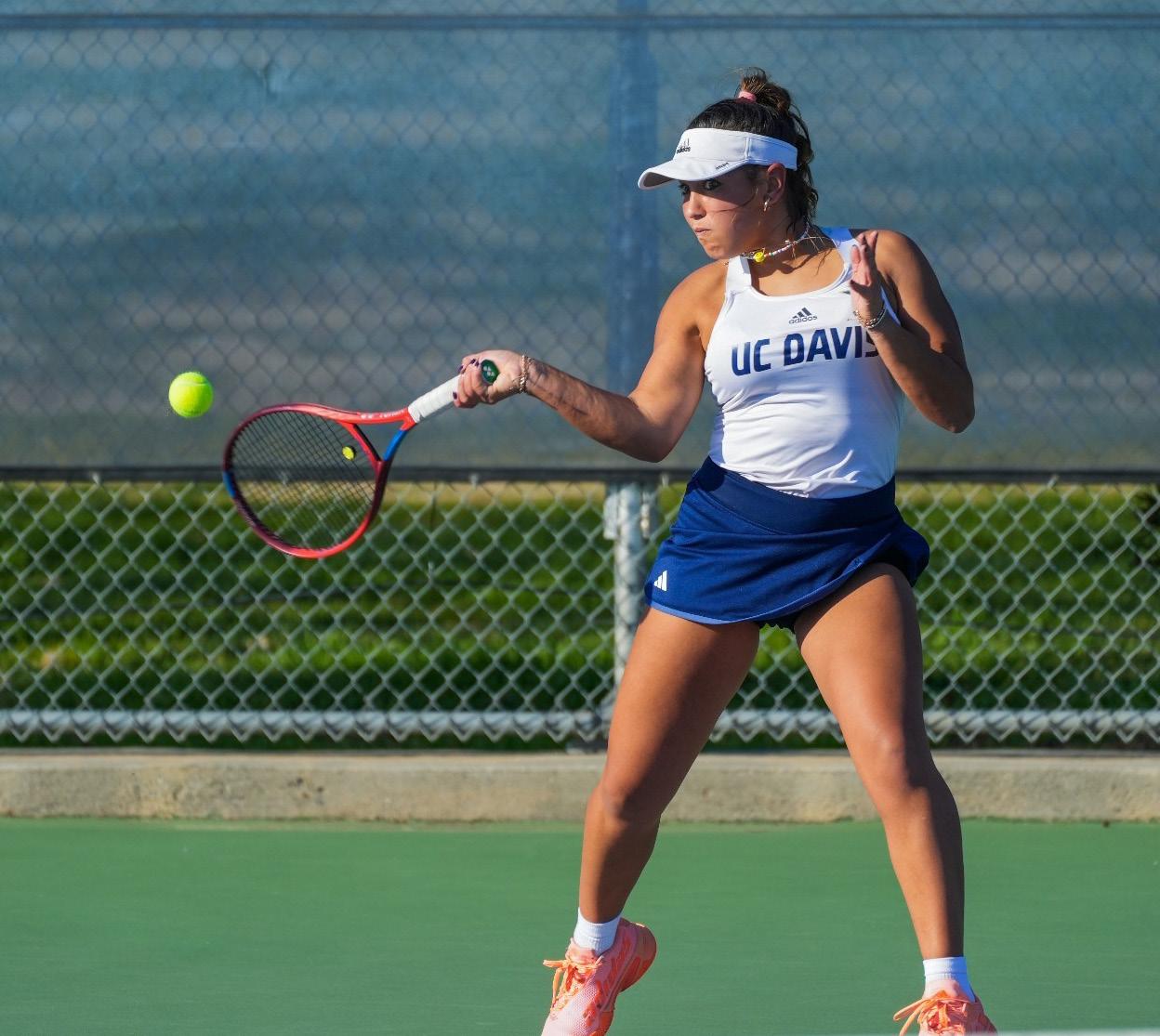
In the last eight minutes of play, the Aggies’ scored 25 points. Most of these were by third-year guard Elijah Pepper, second-year guard Ty Johnson and Adebayo, who had 12, five and six points, respectively.
But despite the Aggies’ best offensive efforts, their defense appeared to fall apart in the fourth quarter. UC Davis kept fouling Mitchell, giving him the opportunity to score seven points from free throws alone.

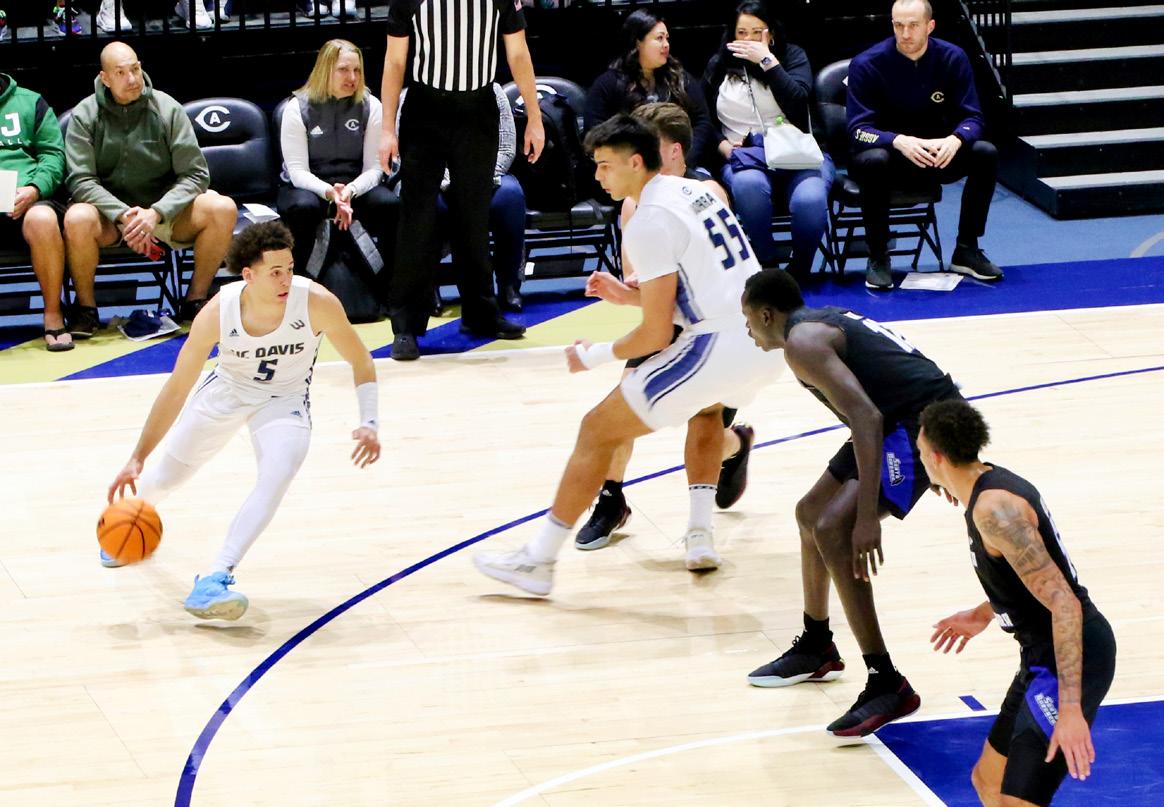
While the Aggies lost their lead earlier in the half, they were holding their own against the Gauchos, keeping the game to a one- or two-point difference in the final minutes of regulation. However, the increased number of fouls called against the Aggies, such as the ones called for Mitchell, ended up contributing to the loss.
With just a minute remaining, the Aggies took the lead back with a layup by Adebayo, making the score 81-82. This lead was short-lived though, as a personal foul was called against Adebayo, giving Mitchell the chance to score two free throws, taking the lead for the Gauchos once again, 83-82. The lead went back and forth down
BASEBALL
to the last 20 seconds, when the Aggies were down by just two points, 85-83. They had just enough time to make a play, but, two personal fouls called on third-year guard Kane Milling sent the Gauchos’ two leading scorers of the night, Mitchell and fourth-year guard Josh Pierre-Louis, to the free-throw line. Combined for four points, they secured the lead 89-85 with just 12 seconds remaining.
UC Davis’s missed free throws and lackluster defense in the final minutes cost them the game, which ended with a score of 89-86.
“You can’t do that with a good team. It puts a lot of stress on your offense when you give up 89 points on your home floor,” Les said.
While defensive mistakes in the fourth quarter cost the Aggies the game, there were still players that had great performances throughout. Pepper not-so-shockingly had the most points scored on the team with 30, but Johnson and Adebayo were also strong offensive contributors, adding 13 and 10 points, respectively.
Even though this loss was a tough one for UC Davis players and fans,
they still have a chance to do well in the postseason. Close losses and strong efforts against top Big West competitors prove that they can hang with the top teams in the conference. Though UCSB is ranked first in the conference and the Aggies are ranked seventh, the Aggies played a hard-fought battle against the Gauchos, never giving them a comfortable lead. If they are able to clean up the mistakes they made toward the end of the second half, they have a chance of making a long playoff run this season.
“We have to execute and pay attention to details, and we have to learn how to play with a lead,” Les said postgame.
A few days later on March 4, UC Davis closed out the season with a win against Long Beach State at home. They defeated The Beach in a doubleovertime thriller, 93-92. With the win, the Aggies secured the sixth seed in the Big West Conference and a slot in the quarterfinals. Up next, UC Davis will travel to Henderson, Nevada and play the third seed in the Big West postseason on March 9 at 8:30 p.m.
New rules will change how professional baseball is played
The MLB has implemented new rules for the upcoming season, including a pitch clock, shift restrictions, bigger bases and more
BY PATRICK FIGUEROA sport@theaggie.org
For the 2023 Major League Baseball (MLB) season, fans are going to see a very different on-field product comparison to previous years. The MLB Joint Competition Committee voted in favor of implementing new rules for the upcoming season, including shift restrictions, bigger bases, a pitch clock, a permanent “ghost runner” and limits on position players pitching.

MLB Commissioner Rob Manfred spoke about the new rules in a press conference.
“Our guiding star in thinking about changes to the game has always been our fans,” Manfred said. “What do our fans want to see on the field?
The Davis women’s tennis team beat the Montana State Bobcats. (Courtesy of Leroy Yau / UC Davis Athletics)
BY EVA MACHADO sports@theaggie.org
The UC Davis women’s tennis match was in danger of being canceled on Saturday, March 4 due to bad weather conditions; rain pushed the original starting time of the match back to 4 p.m.
But despite an unsure start to the day, the Aggies still came out with a strong start and finished with four straight victorious matches to win the contest. This win extended the Aggies’ winning streak at home, which began on March 2 against the University of Montana Grizzlies, who they beat six sets to one.
Of the six UC Davis singles players, two shut out their opponents. Secondyear Arianna Stavropoulos and thirdyear Carly Schwartzberg defeated their Bobcat opponents in straight sets. These wins set the stage for the Aggies’ dominance over the Montana Bobcats.
Stavropoulos dominated her competitor, winning her first set 6-1 and her second set 6-2. Stavropoulos’s power showed throughout her sets. Her serves were strong and she held a consistent lead over her opponent.
Similarly, Schwartzberg had the clear upper hand in her sets, shutting out her competitor in the first set and winning 6-1 in the second set. Schwartzberg appeared determined and focused throughout her sets —
beginning with powerful smashes and serves that carried through the entire match.
This strong singles play as of late has UC Davis tennis trending upward in the current season’s standings. Fourth-year Yana Gurevich and third-year Michelle Zell also put out strong performances, bringing in the next two points UC Davis needed to defeat Montana State.
Gurevich won in three sets, taking the first and third sets. She lost to her opponent in the second set, but managed to come back with a punishing lead in the third and final set to win it 6-2.
Zell ended the match day a win in a tie-breaker at the end of her second set, 7-1.
First-year Kaia Wolfe and thirdyear Olive Maunupau did not have the opportunity to finish their sets, as the Aggies’ had already taken the contest after four straight wins. Wolfe and Maunupau both played strong games, winning one set each before their sets were left unfinished. Wolfe started strong, winning her first set and holding the lead throughout her second set while Maunupau had one win and one loss at the stopping point.
Thanks to Saturday’s win, UC Davis has a record of 5-7 going into Friday’s game. The Aggies will finish out their homestand on Friday, March 10 against the Hawai’i Rainbow Warriors, where they will look to continue their winning streak.
We’ve conducted thorough and ongoing research with our fans, and certain things are really clear — Number one: fans want games with better pace; two: fans want more action, more balls in play; and three: fans want to see more of the athleticism of our great players.” Manfred also mentioned that the new rules have been tested and refined in the minor leagues in recent years. He estimates that they were tested in about 8,000 Minor League games last season, which is the equivalent of three-and-ahalf MLB seasons.
The introduction of the pitch clock is supposed to improve the game’s pace. The amount of time allotted to throw a pitch will vary depending on the ingame situation: 15 seconds with no runners on base and 20 seconds with runners on base. If the pitch clock expires before the pitcher throws a pitch, then the umpire will automatically call a ball. In addition, hitters need to be in the batter’s box and ready to hit with eight seconds left on the pitch clock. Failure to do so will result in an automatic strike.
MLB found that the pitch clock decreased the length of the game by 25 minutes in the minor leagues. For a league in which the average game length has increased by half an hour since 1972, the pitch clock will hopefully be able to return game length to what it once was. So far, during the 2023 spring training, the average game length is two hours and 39 minutes — a 22-minute decrease from the previous year’s spring training.
Also related to the new pitch clock rules, pitchers will be limited to two disengagements — a pick-off move to tag a runner on base or to step off the mound — during each at bat. Exceeding
the limit will allow any runners on base to advance to the next base (e.g. a runner on first base can freely move to second base). In addition, hitters will only be allowed to call one timeout during the at-bat. MLB found that this rule increased stolen base attempts by 26%.
New regulations regarding infield shifts are also being introduced. Prior to this season, MLB defenses could implement various types of shifts, which are instances when three infielders line up on one side of the field because hitters are more likely to hit in that direction. When a shift is implemented, there are generally fewer balls in play, and “three true outcomes” baseball — plays ending in a strikeout, walk or home run — increased significantly.
MLB is introducing shift restrictions to help increase the amount of balls put in play. At least one infielder must be positioned on each side of second base when the pitch is released, and infielders are also prohibited from going into the outfield before the ball is in play. MLB found that shift restrictions increased batting average, lowered strikeouts and gave players the opportunity to show off more athleticism.
First, second and third bases are also increasing from 15-by-15-inch squares to 18-by-18-inch squares. Larger bases are designed to decrease the distance between each base and encourage players to steal bases more frequently. In addition, MLB found that the change decreased injury events near the bases by more than 13%.
The automatic “ghost runner” in extra innings has also become a permanent rule for the regular season; implemented in 2020 to preserve player health and safety in the postseason,
the ghost runner rule meant that there would be an automatic base runner on second base once the game went to extra innings. This was found to decrease the likelihood of marathon games that reach 13 or more innings. For instance, during the 2022 MLB season, only 11 games reached the 13th inning in comparison to 37 games in 2019. The last change is that position players can only pitch in games under certain circumstances: when the game is in extra innings, a team is trailing by at least eight runs or winning by at least 10 runs in the ninth inning. Prior to this season, position players could pitch at any point in which their team was down by six runs. This resulted in an MLB record 132 pitching appearances by position players last season. MLB managers took advantage of this rule to help relief pitchers stay fresh and healthy, but it compromised the level of play in some games. The new rule will encourage teams to keep up competition throughout the entire game.
So far in spring training, the biggest controversy about the new rules has surrounded the pitch clock. Fans were upset when the Boston Red Sox vs. Atlanta Braves game ended in a tie because of a pitch clock violation by the hitter. While the result does not affect either team’s record since it was a preseason match-up, it was a reminder that both players and fans will have to adjust to the new rules in the upcoming season.
With the implementation of new rules, MLB is ushering in a new era of baseball with a faster pace of play and more action. Fans wonder how this season will play out, but there is only one way to know: playing ball.
SPORTS 12 | THURSDAY, MARCH 9, 2023 THE CALIFORNIA AGGIE
Guard Kane Milling takes a shot against Santa Barbara. (Jersain Medina / Aggie)
Guard Robby Beasley III makes his way down the court against the Santa Barbara Gauchos. (Jersain Medina / Aggie)
JOANNE SUN / AGGIE



















 BY JENA TUFAIL jjtufail@ucdavis.edu
BY JENA TUFAIL jjtufail@ucdavis.edu



 BY MAYA KORNYEYEVA mkornyeyeva@ucdavis.edu
BY MAYA KORNYEYEVA mkornyeyeva@ucdavis.edu





 BY CHRIS PONCE arts@theaggie.org
BY CHRIS PONCE arts@theaggie.org
 BY SARAH HAN arts@theaggie.org
BY SARAH HAN arts@theaggie.org









 BY PRISCILA JIMÈNEZ CORRALES vjthen@ucdavis.edu
BY PRISCILA JIMÈNEZ CORRALES vjthen@ucdavis.edu
 BY LIDYA SHCHERBAKOVA lvshcherbasbpfile@ucdavis.edu
BY LIDYA SHCHERBAKOVA lvshcherbasbpfile@ucdavis.edu








